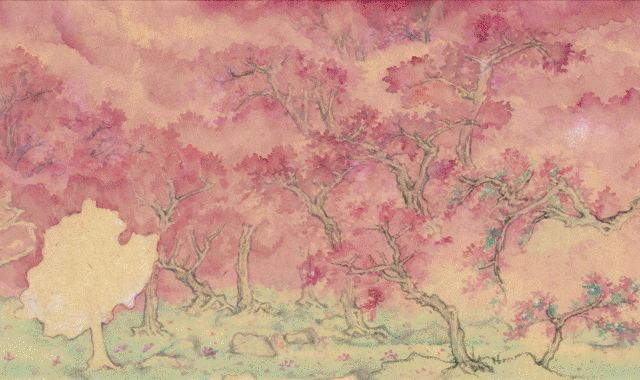
This interview was conducted at Qiu Ting’s Studio in Beijing. The small courtyard with purple tiles and yellow walls were reminiscent of the yellow of Lingyin Temple in Hangzhou. There was an inscription of “Di Cui” decorating the small ancient pavilion, together with a shower that day and few pine trees in the courtyard, a kind of peaceful Zen inspiration was constructed, as long as the “dynamic” pink courtyard gate can be ignored by the visitors.
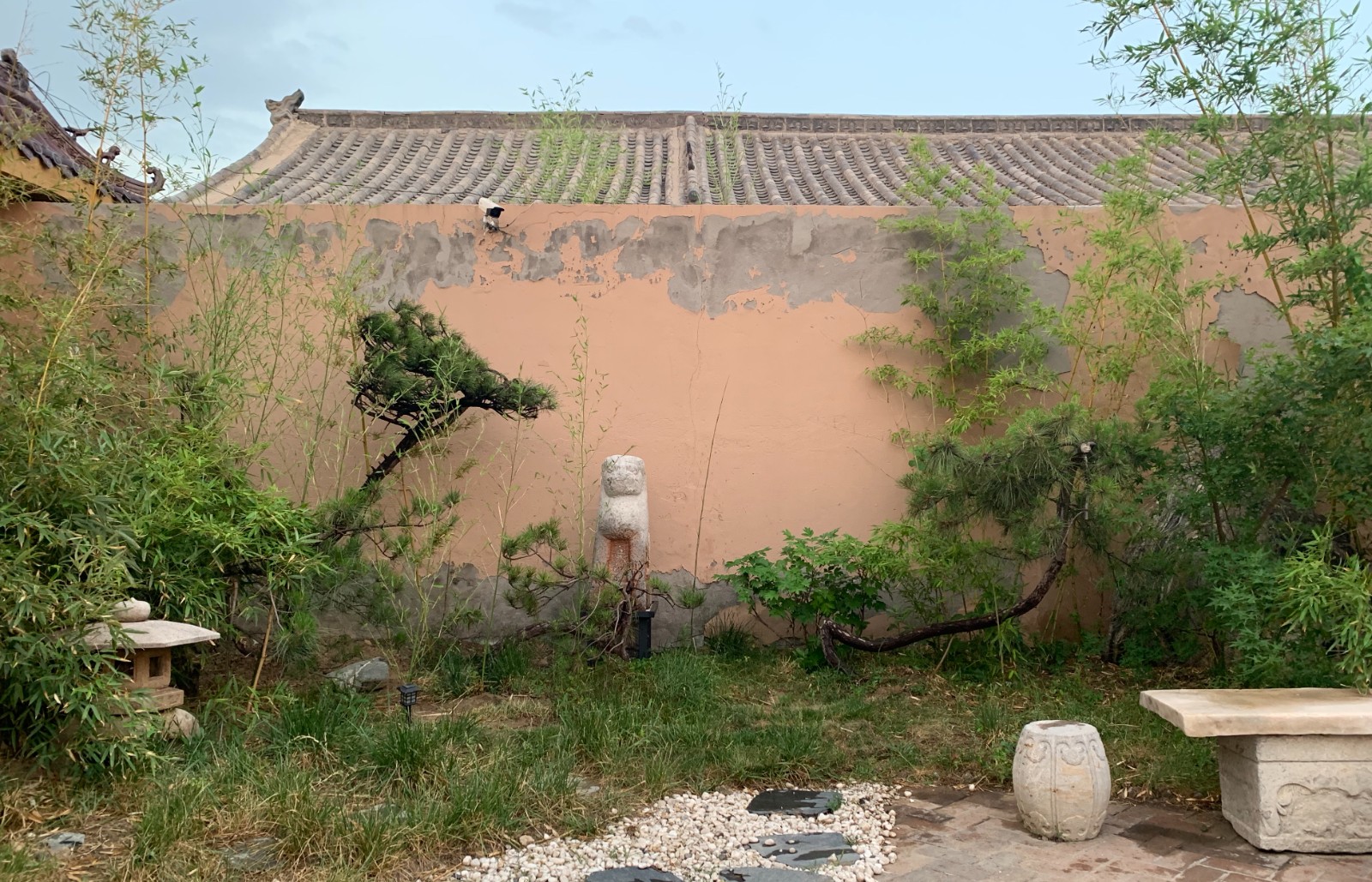
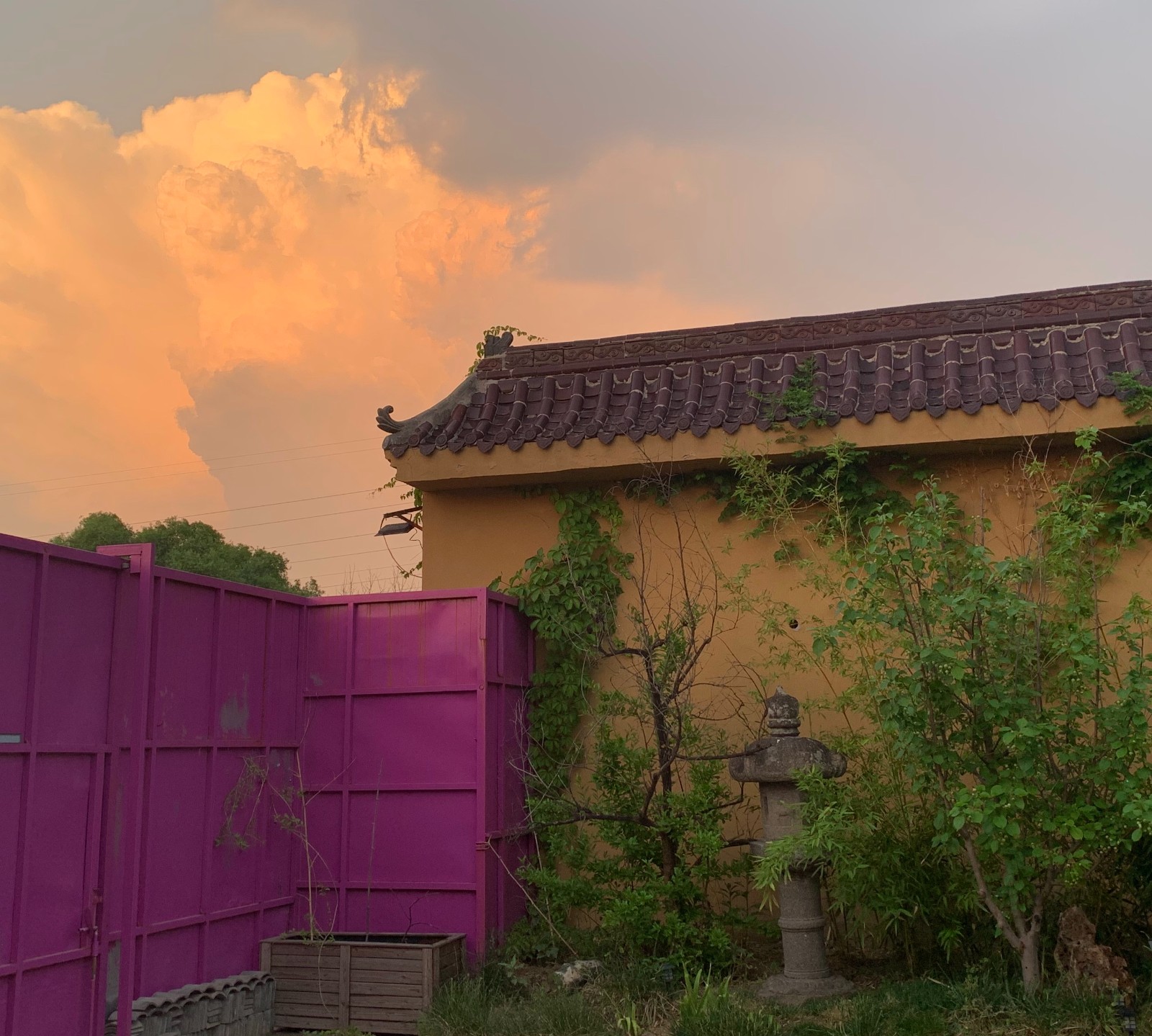
The Courtyard of Qiu Ting's Studio
Regarding the color choice of this door, Qiu has his own interpretation, “Ink painters in most people’s impression, are usually in black, white and gray tones just as they usually wear traditional Chinese costume and drink tea, but this pink gate is both my ridicule and rebellion against this stereotype, which actually represents a certain state of my life.”
What’s more interesting is that the pink context and contrast seem to have also been reflected in Qiu Ting’s latest solo show entitled as “My Heart is in the Hills” presented by Daqian Gallery in Beijing.
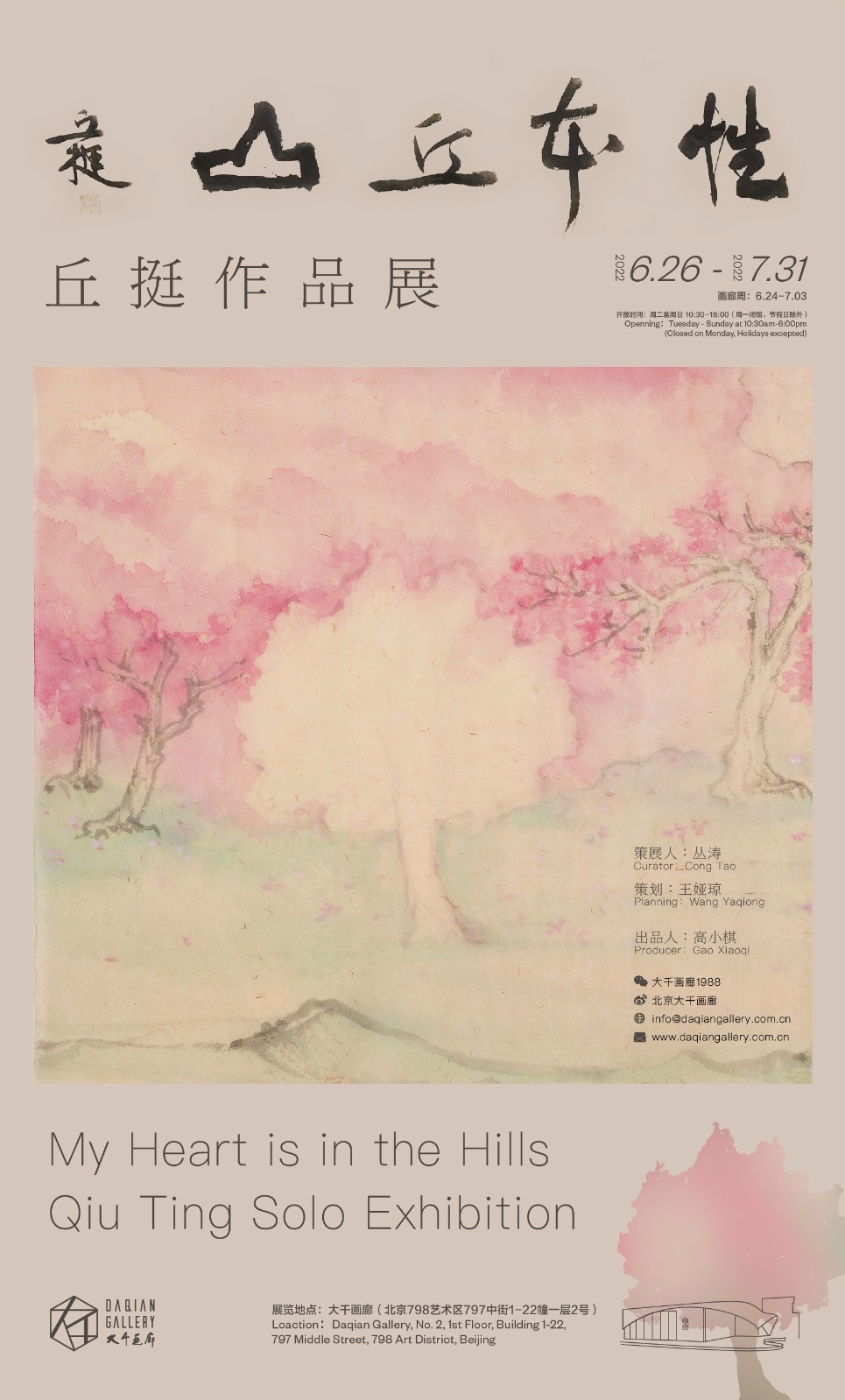
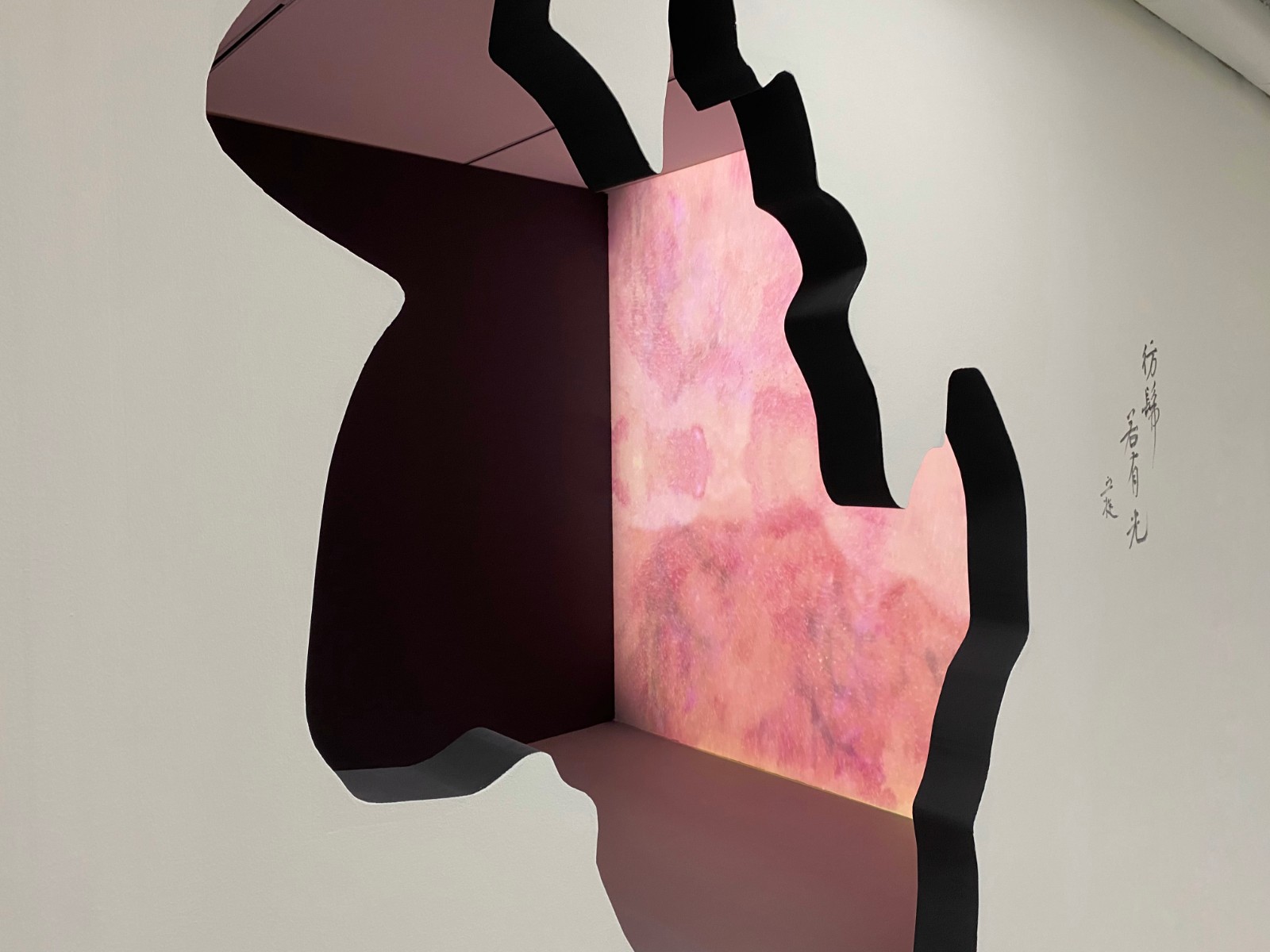 Exhibition View
Exhibition View
Visitors can find the “dreamland” and reality, warmth and darkness, preservation of ancient heritage and innovation, Zen detachment and various “restless” visual elements have all been integrated and displayed on the scene, which became parts of the “Peach Blossom Spring” that were recreated by Qiu Ting in 2022.
“My Heart is in the Hills” is the most central work in the exhibition, which belongs to the “Peach Blossom Spring” series Qiu had recently created. In 2021, after Director Lai Shengchuan visited “Inviting the Moon and Wind—Exhibition of Qiu Ting’s Works” with the temperament “l(fā)ike a dream, like a fantasy” , they agreed to collaborate on the stage art of the new version of “Secret Love for the Peach Blossom Spring.”
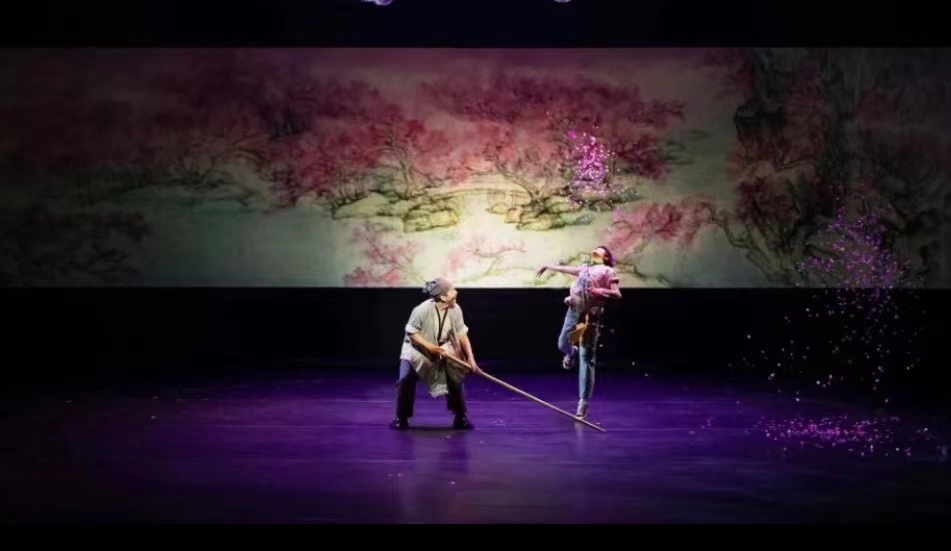
A Still of “Secret Love for the Peach Blossom Spring” in 2022, Photography by Wang Kai
The follow-up triggered by this cooperation was Qiu Ting’s continuous expansion of the image of “l(fā)ike a dream, like a fantasy” in his individual creations, “During that time, I have been painting ‘Peach Blossom Spring’, which originated from the escape from a dream, it subtly passed through my subconsciousness and eventually led to several works in the ‘Peach Blossom Spring’ series that moved towards imagery.” The “Peach Blossom Spring” series was officially completed.
The motif of “Peach Blossom Spring” for Chinese painters, means that the creators need to show more courage to face the classics. Such a classic motif, which has been repeatedly shaped by Chinese painters from various dynasties, is not only a unique spiritual landscape that exists in the heart of every Chinese person, but at a symbolic level, it is also a unique “Utopia” for Chinese people: how to shape the “Peach Blossom Spring” in the moment, which is almost the same as how to face the current era.
 Installation View
Installation View
As the exhibition curator Cong Tao said, “By intervening in this subject matter, Qiu Ting enables his artistic expression to enter the sequence of historical texts and images, and is a way of ‘surpassing the ancients’ which endows his work with a unique quality of transcending the present.” [1] Qiu Ting undoubtedly chose a very gentle way, which may be related to his current state of mind, or rather, to the state of mind he is trying to achieve and wishes to share with the outside world.
Qiu Ting was trapped in Jiangnan (the Area South of the Yangtze River) throughout the spring due to the pandemic, and he missed the premiere of the new version of “Secret Love for the Peach Blossom Spring” in Shanghai. “Missing the Spring” is not an isolated case for artists. In Qiu Ting’s view, helplessness and missing may also be a form of “affective image”. The important thing is, “How do we adjust ourselves to the best state of ourselves in the face of the present moment, and put peace and compassion in our creations.”
“Peach Blossom Spring is a metaphor for escape. This kind of escape is active, not limited to the body, but also includes spiritual anomie and dissociation.” [2] So the audience can see that there is a peach tree running away in a weird way in the “Peach Blossom Spring” series, which also makes Qiu Ting’s ink interpretation based on the current context acquire a certain contemporary nature, magical and humorous qualities that belong to Pynchon and Márquez. When hardship and distress have become the main tones entrenched in the minds of many people, the colors of the “Peach Blossom Spring” series not only provoke and infect the audience, but the artist was impressed by himself.
 Exhibition View
Exhibition View
In the following interview with CAFA ART INFO, Prof. Qiu talked about the origin of the “Peach Blossom Spring” series and the practical experience brought by cross-boundary cooperation; the creative understanding of “Peach Blossom Spring”; how to carefully arrange an ink-and-wash exhibition with “sound, light, color and taste” including the manipulation of images and ink texture, a digital generation of images, including the use of “inverse method of narrative logic” to create a piece of “Qiu Ting Stone”, and he figured out a set of interesting ink “digital production models” from this schema creation method...
Perhaps the most exciting part is that he started from the creation of the “Peach Blossom Spring” hand scroll. Starting from art itself, with the enthusiasm of “presenting all the greedy ideas of an artist on the hand scroll", he developed his study on the hand scroll, which is the featured media of Chinese painting, as well as his profound sharing, analysis and thinking of his creative experience while traveling between the traditional and contemporary perspectives of ink painting.
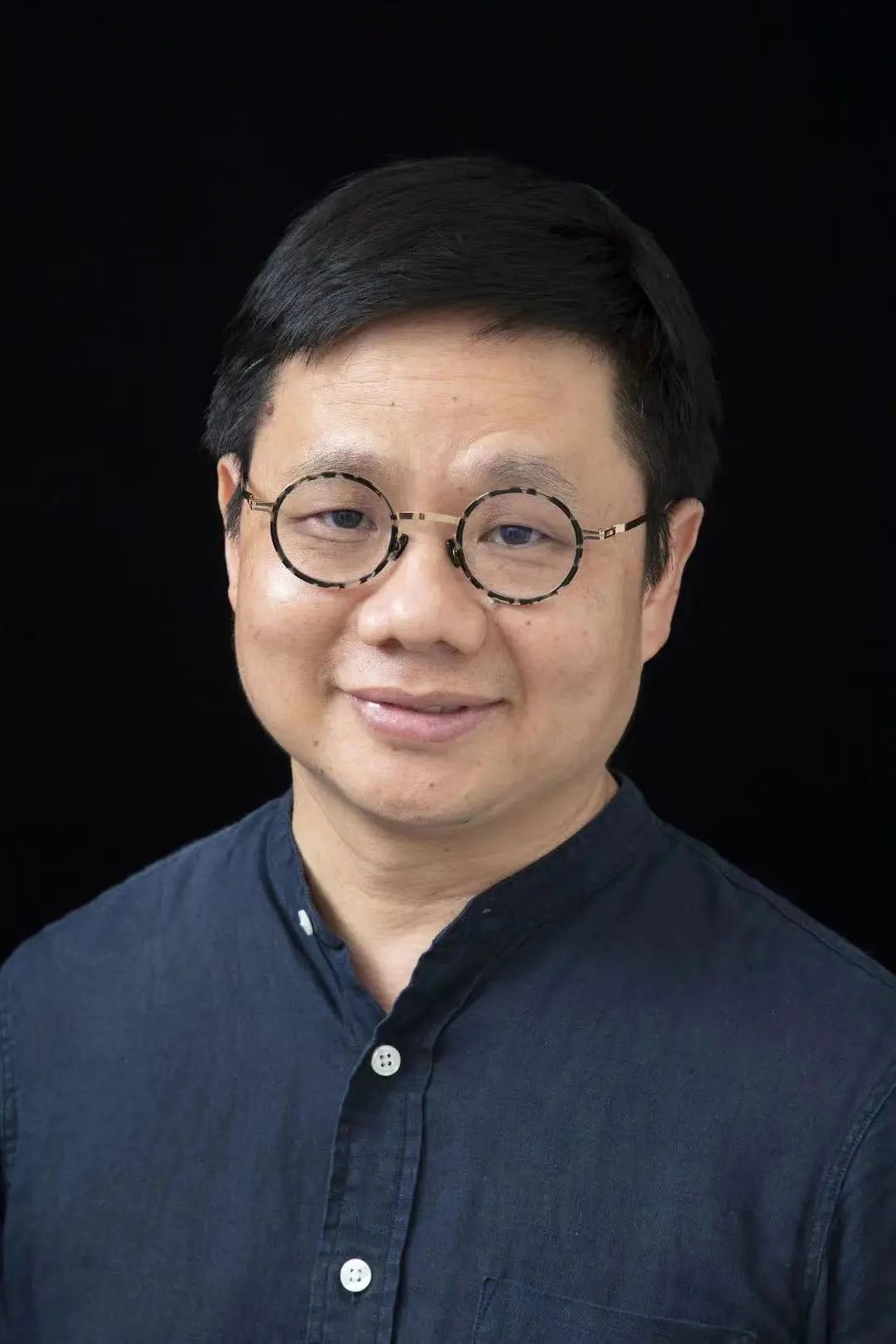
Artist Qiu Ting (Photo by Yoshihiko Ueda) Professor of the Central Academy of Fine Arts, Vice President of School of Chinese Painting, Central Academy of Fine Arts
Currently he lives and works in Beijing.
Interviewee丨Qiu Ting
Interviewer | Mengxi
Edited and translated by Sue/CAFA ART INFO
Garden and Spring | Peach and Escape
CAFA ART INFO: Your new “Peach Blossom Spring” series was born out of the choreography design for the drama “Secret Love for the Peach Blossom Spring” with Director Lai Shengchuan, the “dream-making” characteristics of the stage, the special sense of the stage and the difference in facing subjects, have they made “Peach Blossom Spring” have different characteristics compared to your previous creations in some way?
Qiu Ting: Last year, I had a solo exhibition entitled on “Inviting the Moon and Wind—Exhibition of Qiu Ting’s Works” in Suzhou Museum. Director Lai visited it and he liked the dreamlike feeling in my paintings, which is also the beginning of our cooperation “Secret Love for the Peach Blossom Spring”, and the origin of this solo exhibition “My Heart is in Hills.” This also makes my “Peach Blossom Spring” series have a complex intertextual relationship, including the texts of Tao Yuanming’s “Peach Blossom Spring” and “Secret Love for the Peach Blossom Spring,” and I also need to take the stage space and my personal artistic technique into consideration as the preset for creation which was first of all different from the previous ones.
 “Peach Blossom Spring 9” , 138x34cm, ink and color on paper, 2022
“Peach Blossom Spring 9” , 138x34cm, ink and color on paper, 2022
“Peach Blossom Spring” is a comedy, while “Secret Love for the Peach Blossom Spring”, is a tragedy, and the synergistic narrative has both joy and sorrow. Another follow-up thought triggered by the cooperation with Director Lai is the continuation of my image being “l(fā)ike a dream, like a fantasy.” Many artists may have a similar experience. They have been painting something for a short period of time, and they even dream about it at night. During that time, I have been painting “Peach Blossom Spring”, which escaped from my dream, through my subconscious transformation, finally become several works of the “Peach Blossom Spring” series in “My Heart is in the Hills.”
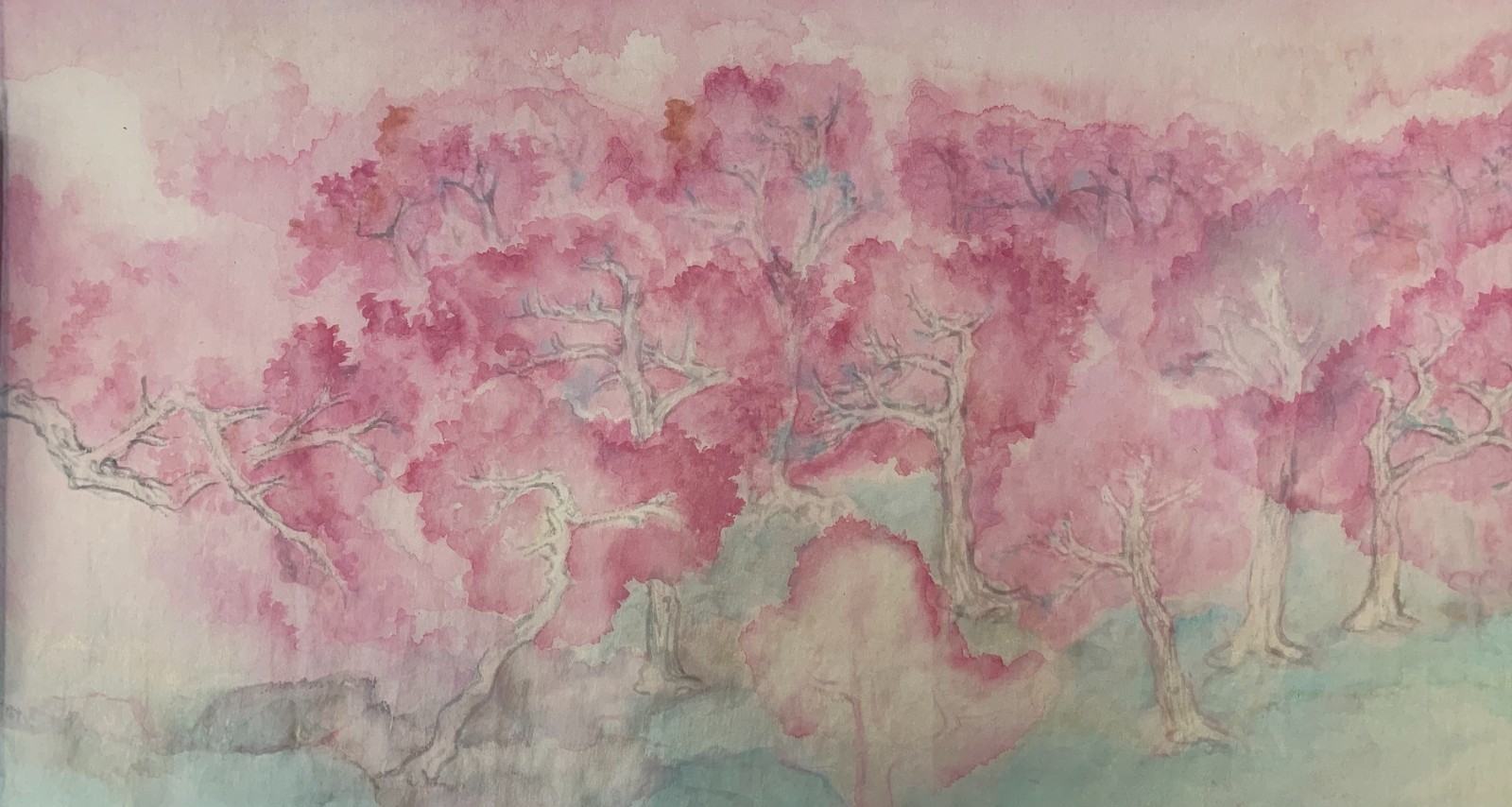 “Peach Blossom Spring 3”, ink and color on paper, 68x35cm, 2022
“Peach Blossom Spring 3”, ink and color on paper, 68x35cm, 2022
CAFA ART INFO: Colors are the most eye-catching part of the exhibition “My Heart is in the Hills.” There are two directions of heavy ink and heavy color in the traditional pedigree of Chinese painting and it is usually thought that the previous one stands for the literati elegance until Li Keran has carried out a color reform in Chinese painting, and your previous creations around landscape and gardens, such as the “Sitting with Whom” series, are mostly ink and wash, which makes the colors in the “Peach Blossom Spring” series far away from your previous works: the extensive use of pink, bright and soft, full of emotion, can it be seen as some kind of experimental innovation that you are working on?
Qiu Ting: Yes, in fact, I have been exploring the colors in ink painting all the time, but others’ impression of me seems to be focused on ink painting. Last year, I had a solo exhibition at the Suzhou Museum. There were many works using color, including the “Sitting With Whom” series, which included several large works with heavy colors. I’ve been working on both perspectives.
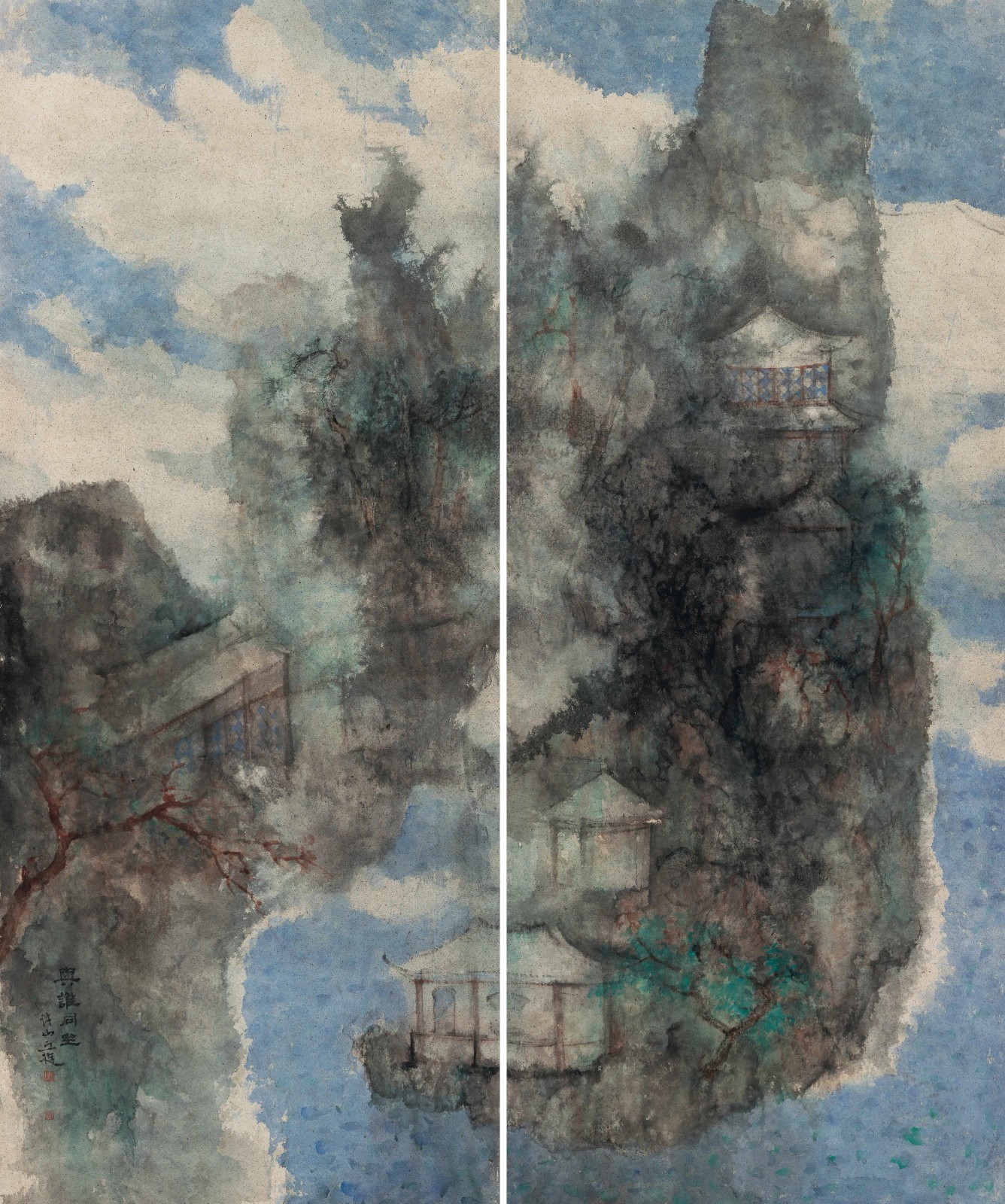
“Sitting With Whom”, ink and color on paper, 240×200cm, 2021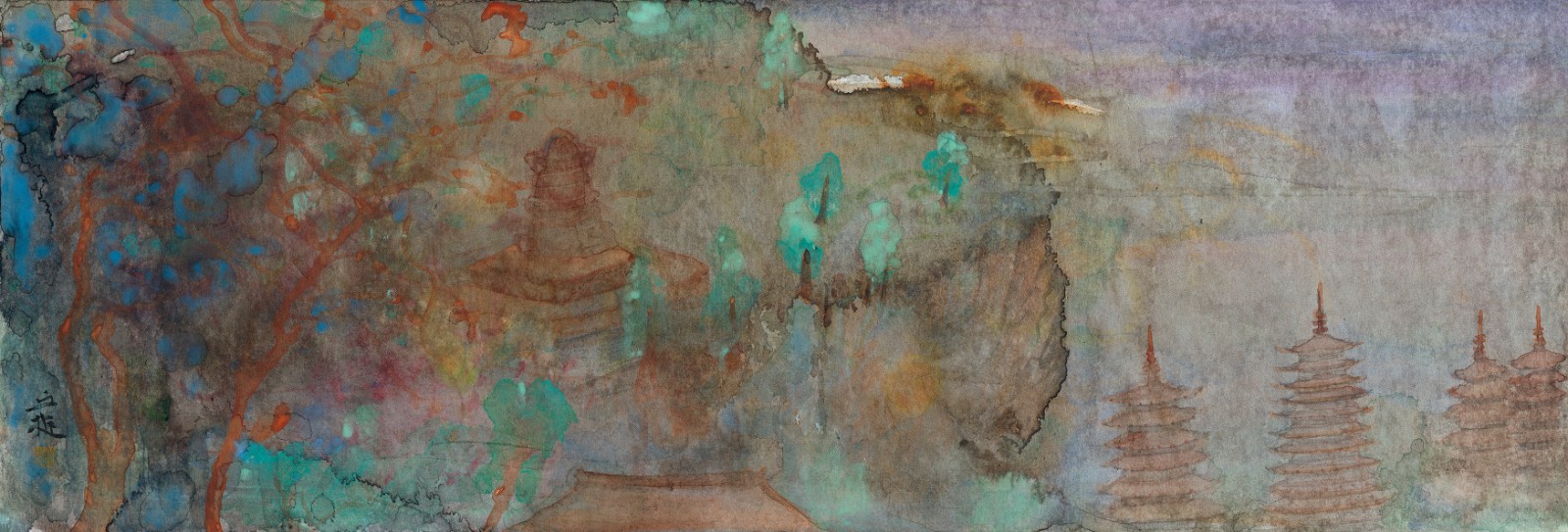 “Yinshan Pagoda Forest”, Ink and color on silver paper, 34×100cm, 2021
“Yinshan Pagoda Forest”, Ink and color on silver paper, 34×100cm, 2021
Going back to the use of colors this time, many of the treatments actually extended my usual creative techniques. It is nothing more than that the colors this time are easier to provoke people’s hearts and are more directional. This change may be related to the current state of everyone’s heart. In the face of everyone’s anxiety and confusion about public order, the more anxious this is the case, the more I think we need some kind of beautiful and splendid colors to soothe our hearts. I have a small painting entitled “Snow River” in this exhibition, which is a gloomy image in gray tones that I painted when my mind was drifting. But the exhibition as a whole is still in a relatively warm and sunny state.
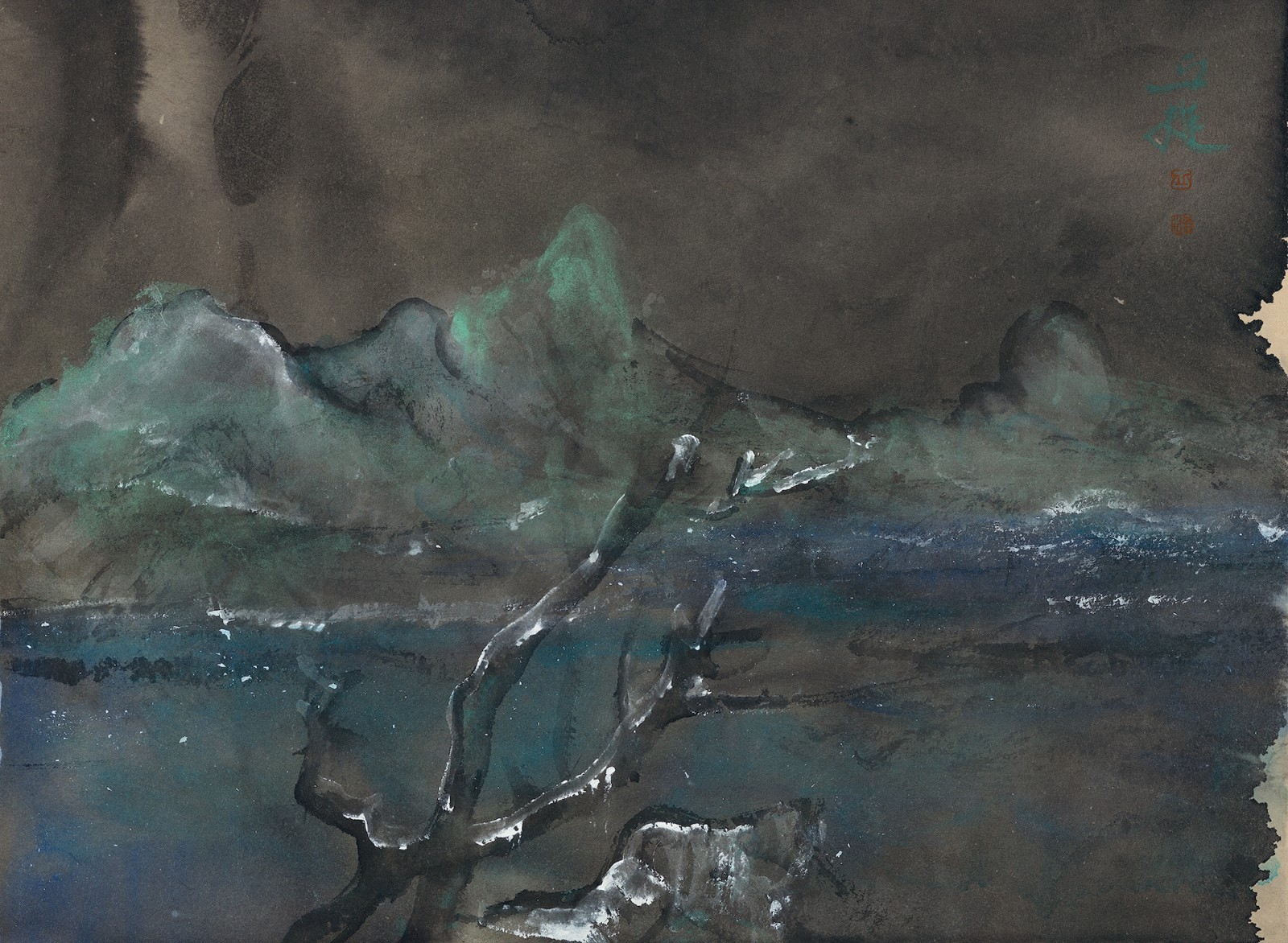 "Snow River", 25.2x34cm, ink and color on paper, 2022
"Snow River", 25.2x34cm, ink and color on paper, 2022
The “Peach Blossom Spring” series is a creation of a more perceptual stream of consciousness. In the selection of pink tones, I also absorbed the influence of Mogu painting from Zhang Sengyao, Dong Qichang, and Yun Nantian.
When it comes to the use of colors, we all know that pink can easily cause a kind of “pinky temperance”, which requires the artist’s control, such as controlling the contrast between dry and wet. In addition, I also used the principle of ink separation and tones to express the imagery of expression of colors, and the physical color gamut as its own trend is based on the psychological rate. The color change in the “Peach Blossom Spring” series is not steep, but I have tried to seek rich layers in gentle development. Through layers of smudges, a subtle pink tone layer like a musical scale is formed. This is also my overall grasp of the color gamut in creations.
 “Peach Blossom Spring 4”, ink and color on paper, 50x35cm, 2022
“Peach Blossom Spring 4”, ink and color on paper, 50x35cm, 2022
 “Peach Blossom Spring 5”, ink and color on paper, 51x34.5cm, 2022
“Peach Blossom Spring 5”, ink and color on paper, 51x34.5cm, 2022
CAFA ART INFO: The “Peach Blossom Spring” series touches on the story with the same title that every Chinese is very familiar with, from your well-known motif of “garden”, to the motif of “Peach Blossom Spring”, from “garden” to “spring”, does it mean a certain creative direction that continues to push toward the inner world?
Qiu Ting: Chinese culture pays more attention to “internalization.” For example, landscape painting is to study the relationship between humans and landscape. “Garden” is a motif between the presence and absence of appearance, and some of the gardens I describe were actually created by myself. A garden is also a “Peach Blossom Spring”, which is the Chinese “realistic version” of the “Peach Blossom Spring.” If “Peach Blossom Spring” reflects Tao Yuanming’s personal state, in which Confucianism, Taoism and Buddhist thoughts are integrated, there are worries and diligence, self-confidence and contentment, as well as peace of mind, since “Peach Blossom Spring” emphasizes an idealized realm. Well, the same is true of gardens. It reflects the Chinese culture of farming and reading, working hard to read books, traveling long distances to start a business or become an official. After they returned home, they built their “Peach Blossom Spring” which were gardens.
These gardens of “Peach Blossom Spring” have many secular qualities, such as the specifications of the hall, the specific furnishings and so on. As an artistic motif, “Peach Blossom Spring” is a universal utopia for human beings, like Walden in the hearts of Westerners, a symbol of ideal habitat that people can escape from the constraints of reality and yearn for freedom. While I worked on the “Peach Blossom Spring” series, a certain state of my present made me more sensitive to inward tendencies, or, in other words, what this theme appeals to is more magnified in our current situation, which also makes me impressed as well.
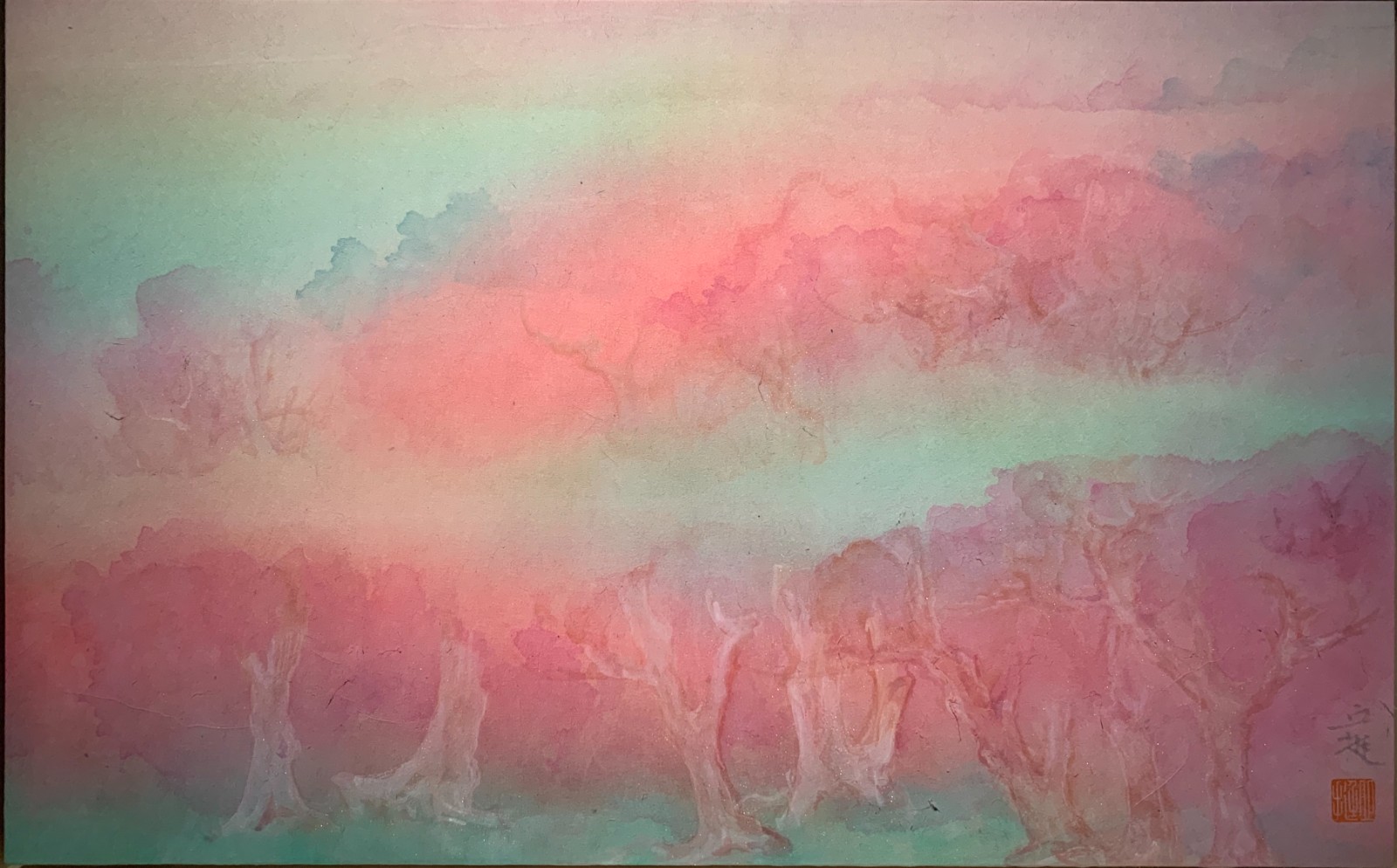 “Peach Blossom Spring 7”, ink and color on paper, 49.7×31cm, 2022
“Peach Blossom Spring 7”, ink and color on paper, 49.7×31cm, 2022
CAFA ART INFO: This exhibition also includes a series of sketches. What are the selection criteria for these sketches?
Qiu Ting: This series of work includes the sketches I painted in Lijiang and Shangri-La two years ago. Painting Lijiang is also my interest in the diversity of regional cultures. Lijiang is the gathering place of the ethnic minority Bai and Naxi. The buildings have cornices, rockeries, and Taihu rocks. It can be said that there is a literati temperament which is usually seen in Jiangnan (the Area South of the Yangtze River).
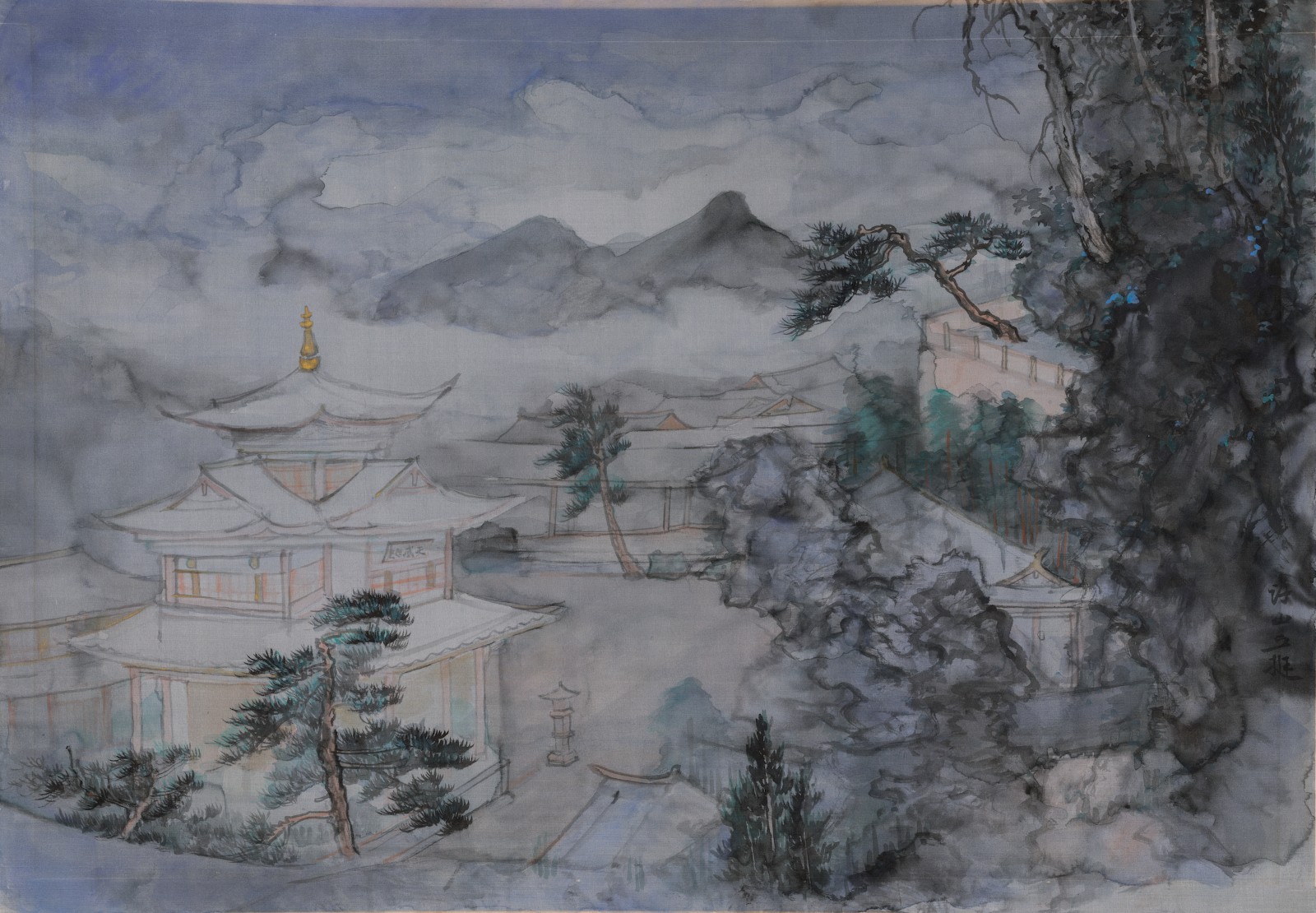 “Sketch in Lijiang”, ink and color on silk, 86.3×61cm, 2020
“Sketch in Lijiang”, ink and color on silk, 86.3×61cm, 2020
The other part of these sketches are some of my sketch paintings, portraying the small courtyard of my studio, an old Japanese pagoda and a few pine trees in the courtyard. The gestures and expectations of these pine trees have been selected carefully by me. Sketching is not only my personal study, but also a daily practice in ink painting. Just like everyone took pictures and posted them on the Moments today, the diversity of ink painting also includes these daily creations. Thus these sketches were included in this exhibition.
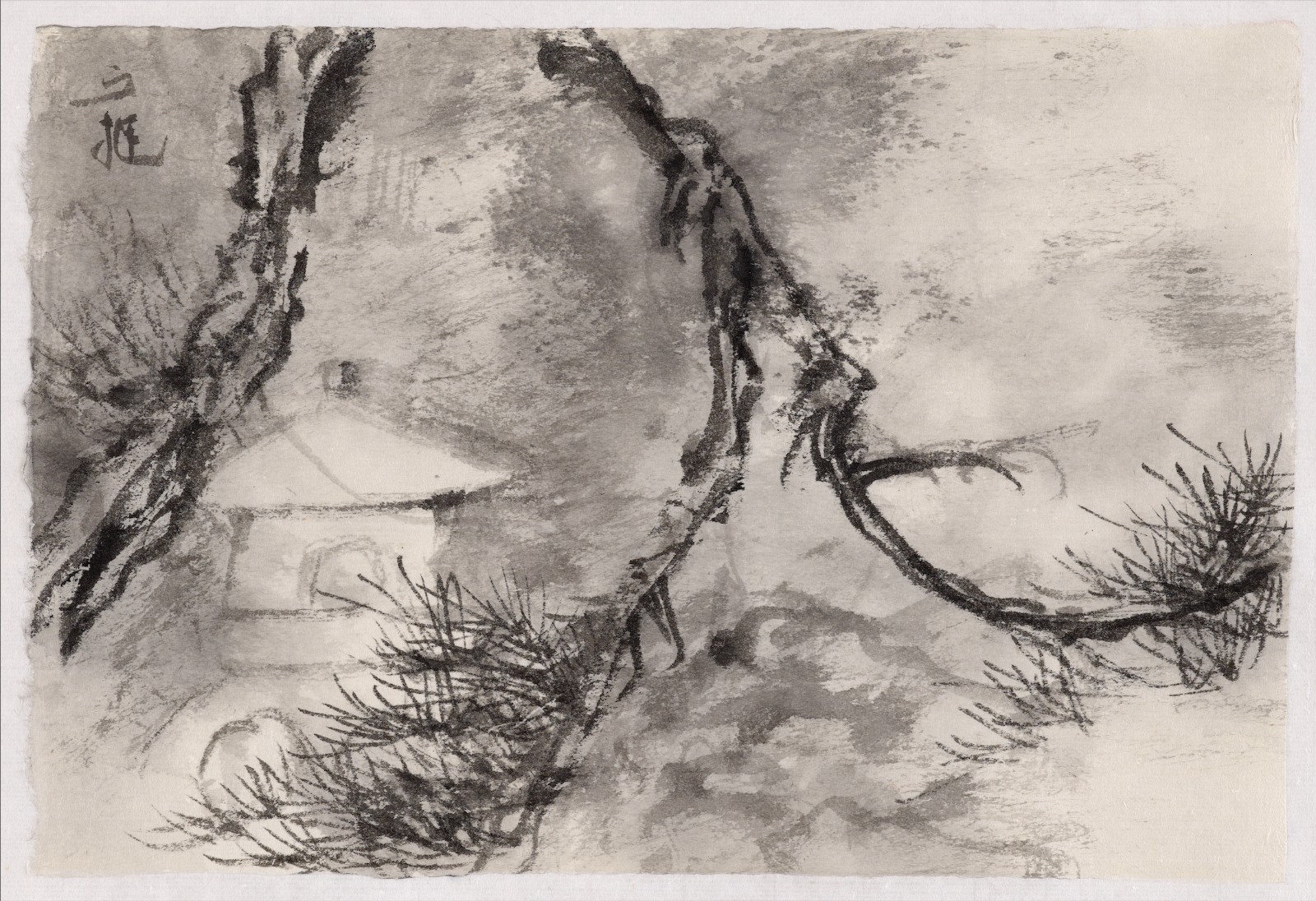 “Ou Zhai Sketch 1”, ink and color on paper 27.5x18.5cm, 2022
“Ou Zhai Sketch 1”, ink and color on paper 27.5x18.5cm, 2022
 “In Spring”, ink and color on paper, 27.3x18.5cm, 2022
“In Spring”, ink and color on paper, 27.3x18.5cm, 2022
 “Liuyi Garden 1”, ink and color on paper, 27.3x18.5cm, 2022
“Liuyi Garden 1”, ink and color on paper, 27.3x18.5cm, 2022
Artists can hand all their greatest ideas to hand scrolls
CAFA ART INFO: You just mentioned the consideration of the relationship between the “Peach Blossom Spring” series and the stage space. Many long scrolls are spatial, even with “stage awareness.” Is the creation of your hand scroll “Peach Blossom Spring” related to that? Is there a certain contextual relationship between it and the schema in the history of Chinese painting? How is it different from your previous hand scroll creations?
Qiu Ting: The creation of this hand scroll is mainly based on my personal accumulation and understanding of traditional schema, plus the text of the play, and of course the creation of the motif on “Peach Blossom Spring” in past dynasties. “Peach Blossom Spring” is a motif that has been repeatedly created by painters of various dynasties, and each narrative is a reconstruction, or even subversion. For example, the works were said to be created by Chen Ju or Qiu Ying, as well as the paintings on “Peach Blossom Spring” by Wen Zhengming, Lu Zhi, Qian Ku, Cha Shibiao, Shi Tao and Huang Shen, etc.. The source of the specific schema may have been unclear for a long time.
I have a lot of experience in viewing and painting hand scrolls, and I have a preference for research in hand scrolls. I am also a Chinese contemporary painter who has created as many hand scrolls as possible. I think among current diverse artistic styles in China, people don’t pay enough attention to hand scrolls. Purely from the perspective of the form, vision and psychology of modern art, a hand scroll is a very perfect form, which contains the value of artistic ontology and is worth exploring.
When I was studying in Zhejiang in the early years, I wanted to express Lingyin Temple of Hangzhou in the form of hand scroll. At that time, I lived in Jinsha Harbor near Lingyin Temple. I painted a few small pieces and formed a good collection of my work in the mid-1990s. I have also been trying to draw Lingyin Temple onto a hand scroll which became an important motivation for me to continue to create hand scrolls.
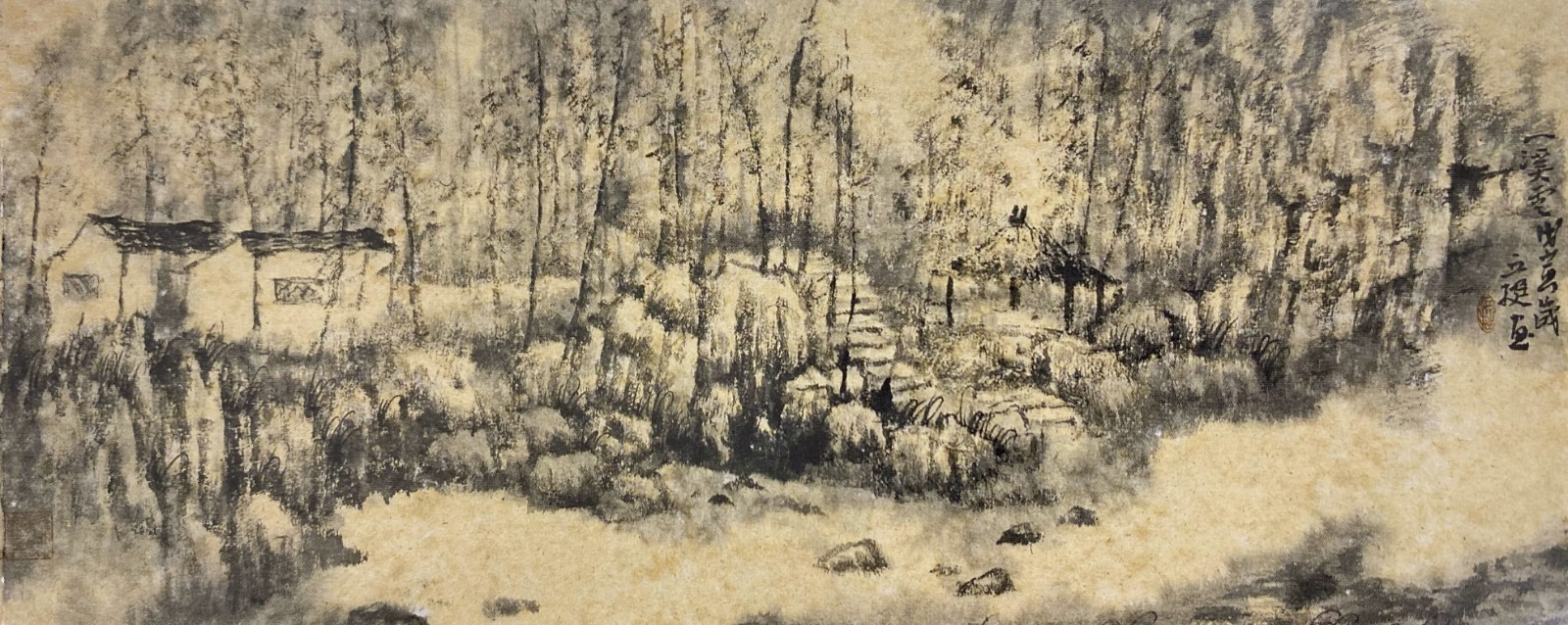 "A Stream of Clouds", 38x79cm, ink on paper, 1998
"A Stream of Clouds", 38x79cm, ink on paper, 1998
Later, when I came to Beijing to study, I found that there was ancient heritage at places like Badachu, Xiangshan and Jingxi and I was excited again. During that time, I often drank tea in Badachu, brewing painting ideas, and drew them onto a hand scroll “A Journey to the Badachu”, which was also my first relatively successful hand scroll. Rather than forms, I value the experimental and contemporary nature of reading and viewing traditional Chinese texts in the narrative logic of hand scrolls.
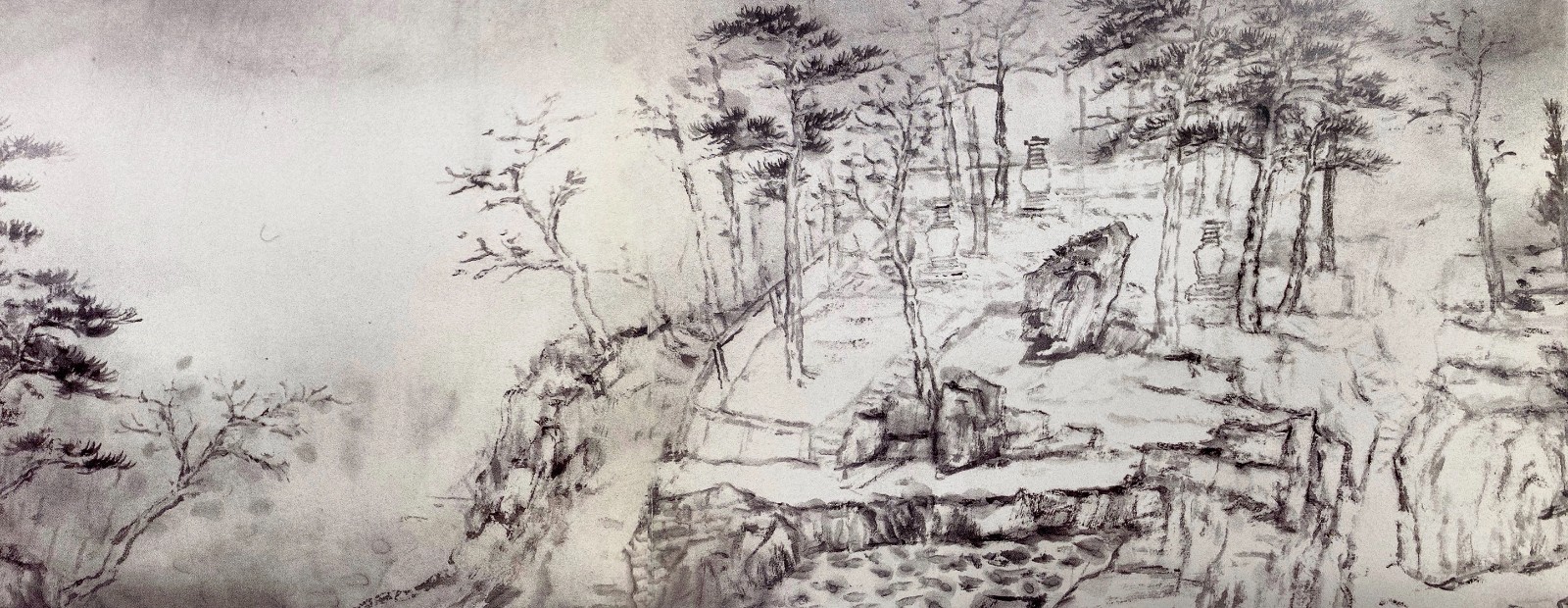 “A Journey to the Badachu”, 34x816cm, ink on paper, 2002 (detail)
“A Journey to the Badachu”, 34x816cm, ink on paper, 2002 (detail)
In my opinion, hand scrolls have a very interesting feature: from the mounting to the psychological state of the viewer, from the elegant frame to the mystery that the viewer will never know: the combination of the painting core, they jointly form a very complete and sophisticated system.
All the ingenious aspects of hand scroll design can impress viewers through the control of materials, rhythm, and the touch of the hands, so that they can calm viewers, and when hearts, hands, and eyes of human beings reach a unified and peaceful state, the “internal heat” will naturally dissipate slowly, and they enter the authentic viewing state.
The narration of the hand scroll is composed of its generation and narrative logic, extending and unfolding in space with the passage of time. The same goes for movies, where the audience follows the narrative based on what is known. The viewers of the hand scroll are also unable to predict the part that has not yet been unfolded, and they need to constantly construct the picture in their minds. Last year, my solo exhibition “Inviting the Moon and Wind—Exhibition of Qiu Ting’s Works” also continued the artistic experience I gained from the creation of hand scrolls.
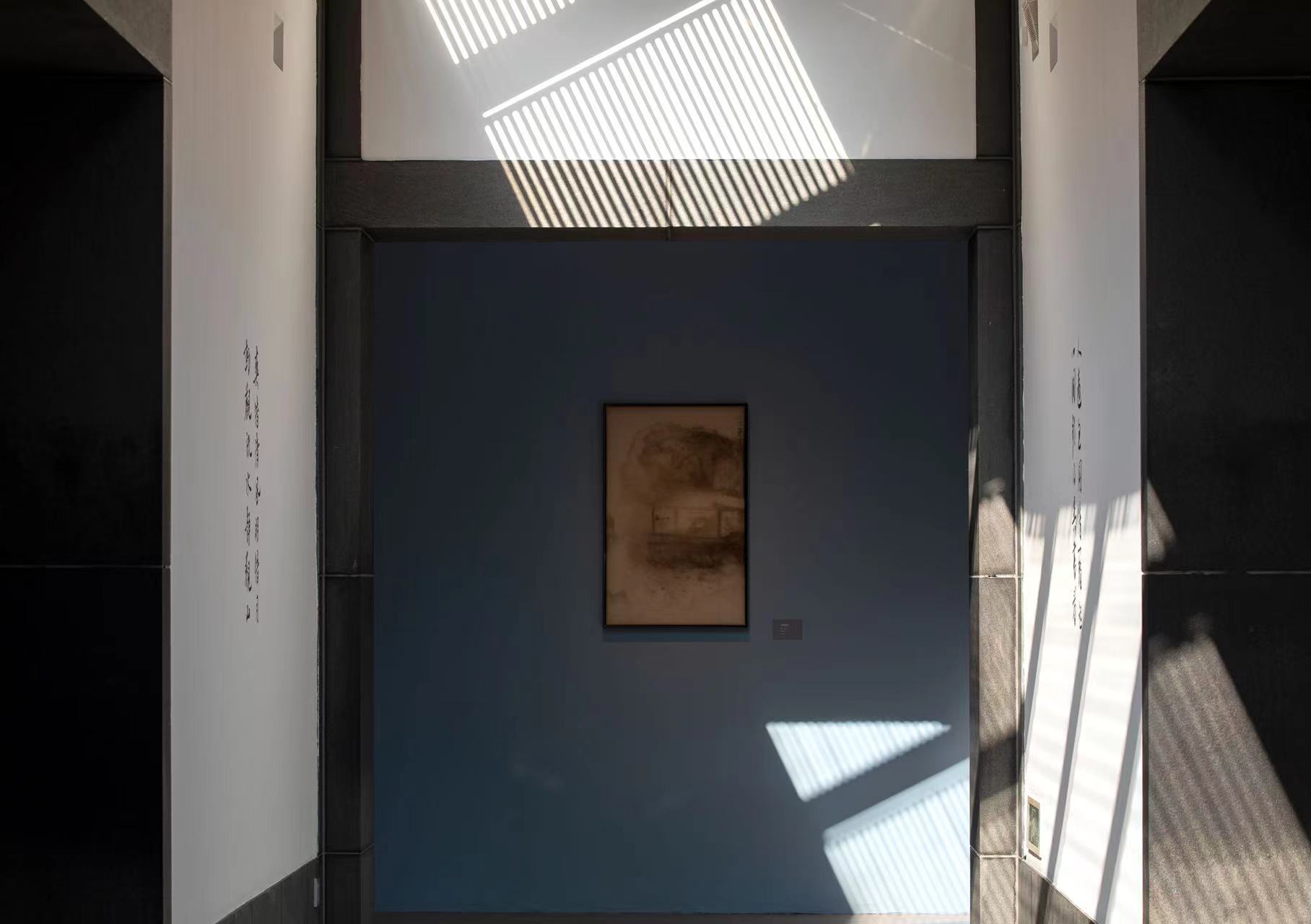
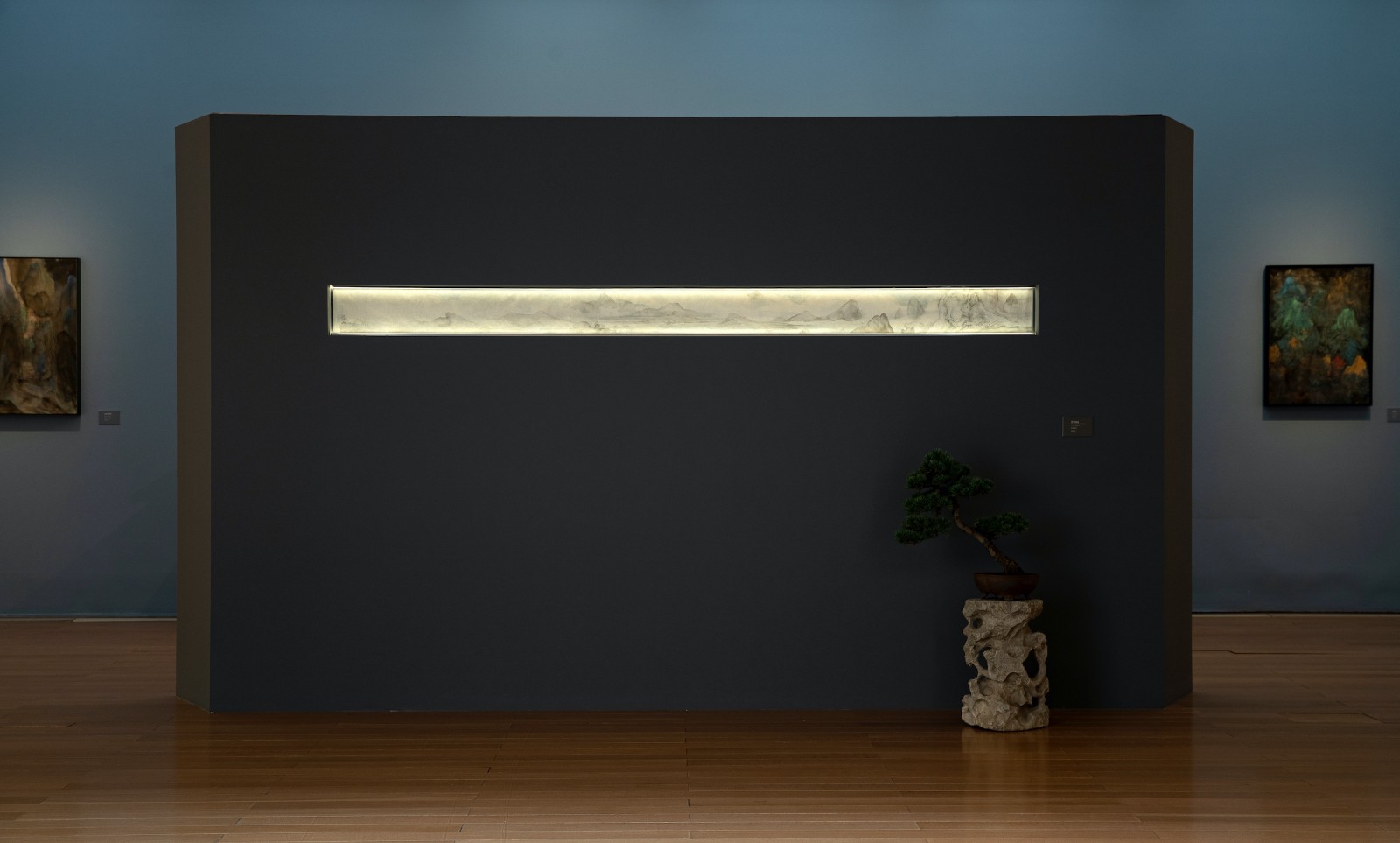 Exhibition View
Exhibition View
When Mr. Ieoh Ming Pei designed the Suzhou Museum, he opened a large window. In my impression, except for Zao Wou-Ki’s exhibition, all the windows were opened, and they have been closed since then. Through this large window, people can see the bamboo shadows, feel the changing weather, the outside and the interior space together form a dynamic and extremely beautiful picture, which gave me the idea of borrowing the scenery and keeping all the windows which were closed for a dozen years open during the exhibition. I painted a hand-scroll with a bamboo shadow, and placed it under the window, so that the scenery of the Humble Administrator’s Garden in the painting unfolds with the bamboo shadow outside the window. Behind the Suzhou Museum is the Humble Administrator’s Garden. In this way, the exhibition has a real echo with the atmosphere and temperament of the time and place. This image of “sitting with whom” is precisely the creative idea that I have continued from the hand scroll.
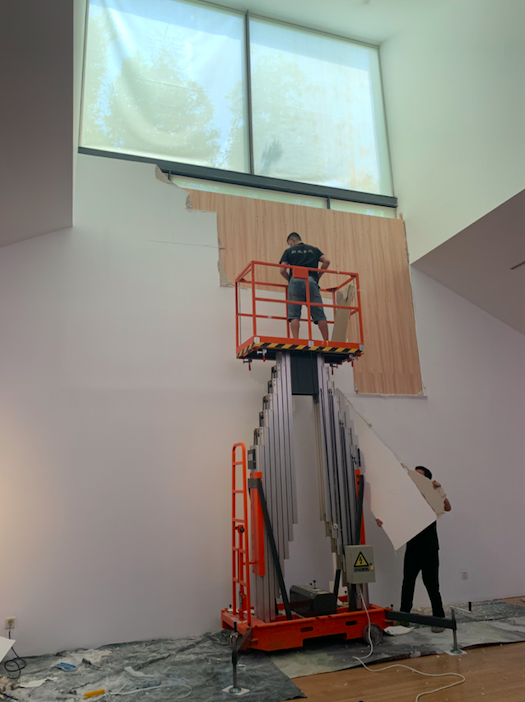
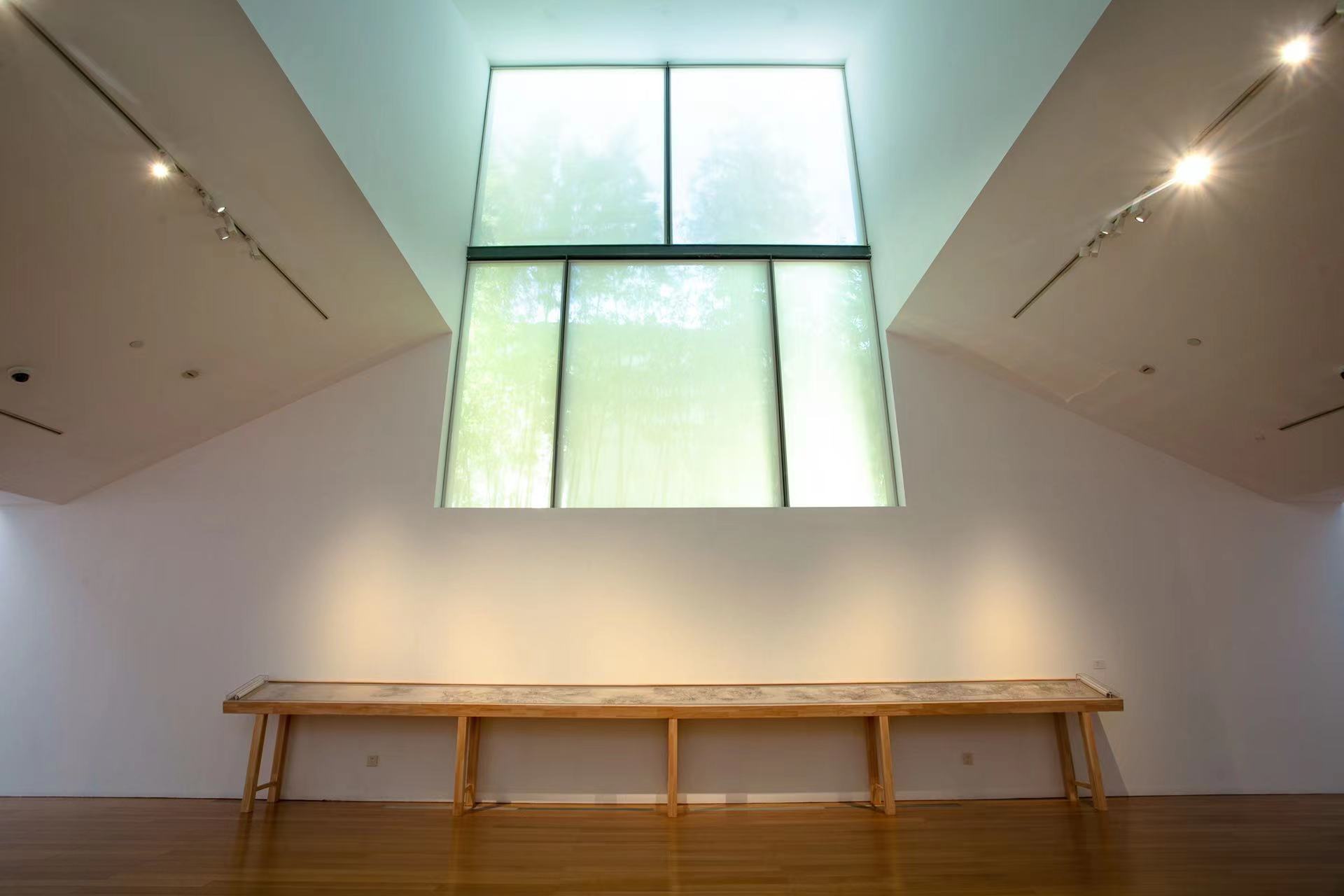 Installation View
Installation View
CAFA ART INFO: As you said, hand scrolls are related to the ritual and physical sense, and are also a complete system. Can it be an extension of the contemporary nature of ink painting?
Qiu Ting: I wrote an article before, talking about the contemporary nature of ink painting from the perspective of the artist practice. I believe that ink and wash have various states: daily, secular, ritual, transcendence, etc.. It also includes narrative logic. The inscription and postscript are not only routine and ritual, but also experimental and unknown. It is a “game” designed by the artist for people who know the rules to play. The different interpretations by each person and the different possibilities presented in the end constitute the unknown and openness in traditional Chinese painting.
But what I want to emphasize is that the various characteristics of ink and wash are not contemporaneous through simple transformation. The creator must have a certain level of education, vision and creative stage at hand in order to sublimate the contemporary things in it. This is also a particularly “squeamish” part of Eastern art. It is full of unknowns and experiments, and at the same time has certain thresholds. It is an important issue worthy of constant research and interpretation by artists.
In 2011, in the duo solo exhibition “The Way from Heart to Art” by Xu Jianwei and I, curated by Wu Hongliang, we tried to use the creative principle of hand scrolls to complete the spatial narrative of the entire exhibition. I hope to reflect and challenge the modernity and democratic viewing methods of today’s art museum system by showing the unique way of creating and appreciating Chinese art.
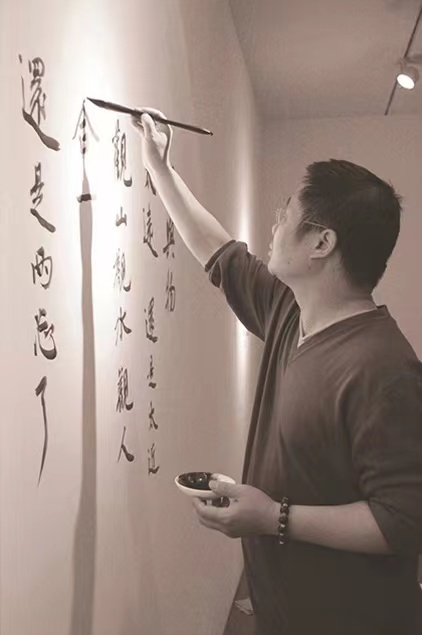
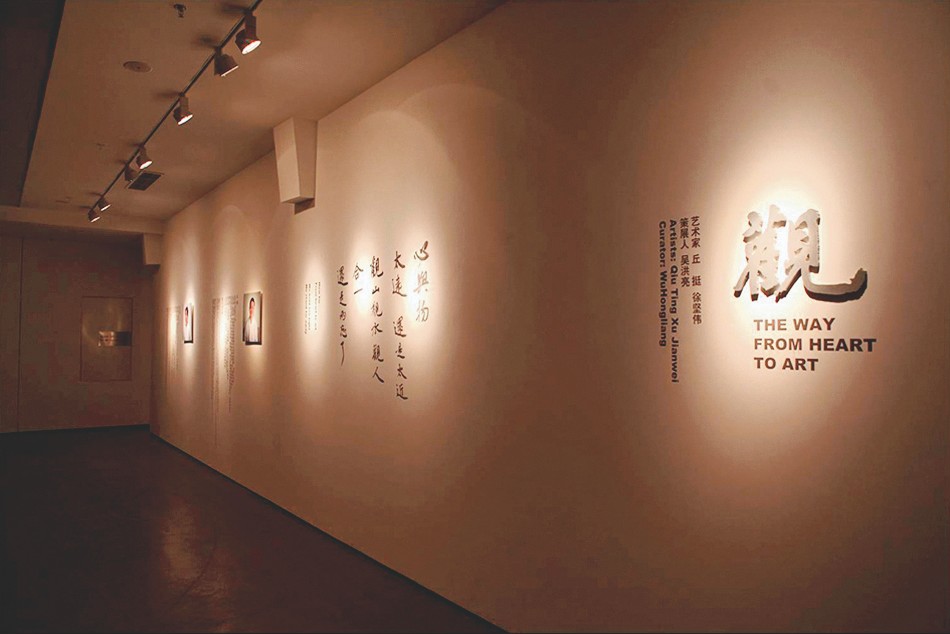
Exhibition View
How to “plant bamboo in the 5G era”?
CAFA ART INFO: Compared with your attempts to widely use different materials and forms such as paper, silk, gold paper, a single-panel, group paintings, and screens in your solo exhibition at Suzhou Museum, “My Heart is in the Hills” is more diverse, including music and video, trying to mobilize more sensory participation of the audience. How to use the medium of “sound, light, color and fragrance” to expand the traditional realm of Chinese painting? How do you deal with the balance between the new media and the traditional Chinese painting?
Qiu Ting: I hosted a forum on the China Painting and Calligraphy Channel not long ago. The title that Mr. Wu Hongliang quoted from a poem by Mr. Xichuan: “planting bamboo in the 5G era.” Bamboo is a symbol of Eastern charm. How does bamboo work in the 5G era? Planting and development is actually a question of how Chinese painting and Chinese art will move towards the future.
I have always liked video, especially the video works by Asian artists. A part of the visual resources of our generation of artists comes from photography and video. I think it is very meaningful and interesting to reconstruct and transform the temperament of ink painting among moving images. Therefore, in this exhibition, I chose to follow the intention of “falling colorful flowers” in “Peach Blossom Spring”, and cooperated with Shanghai LIMAGE STUDIO to create the video work “Peach Fantasy.”
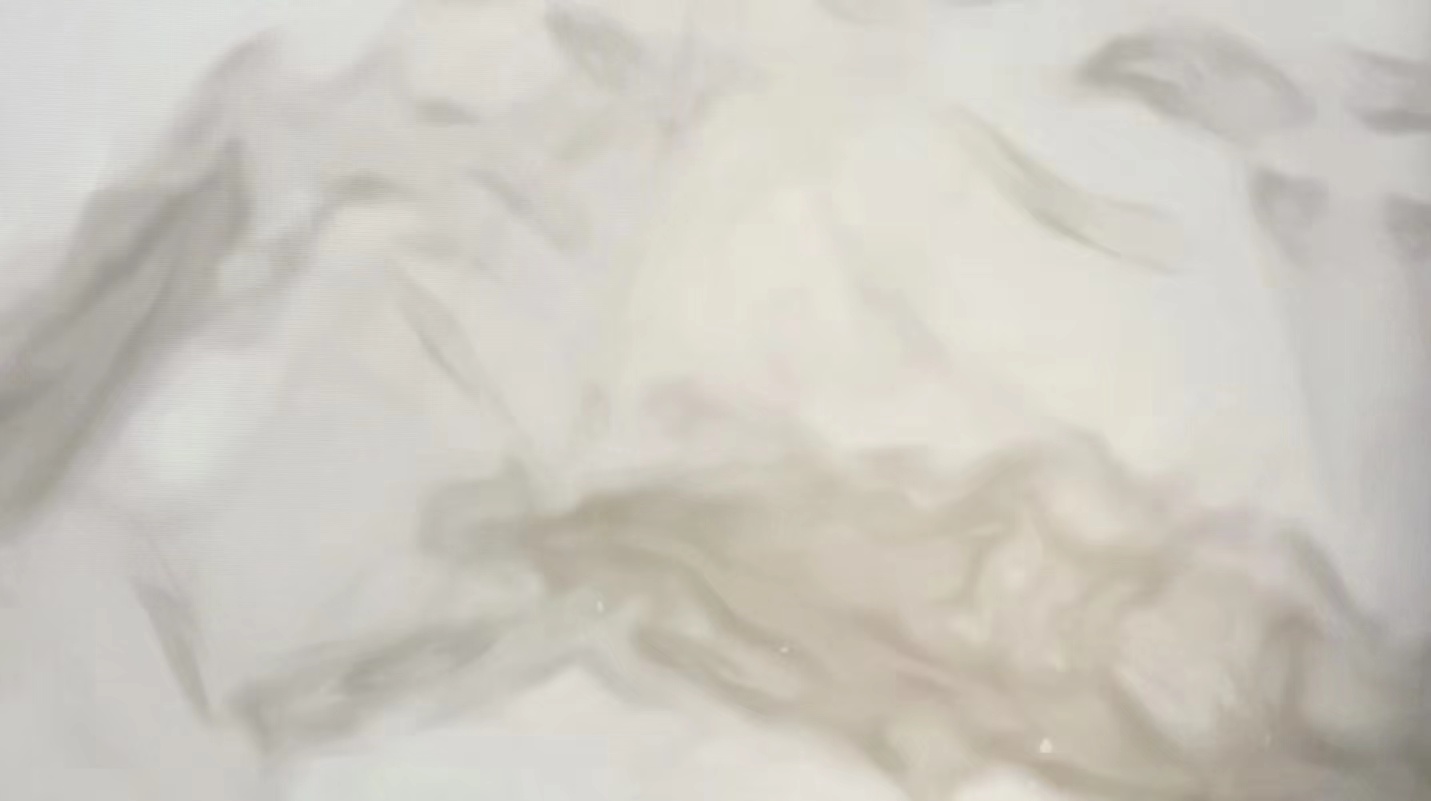
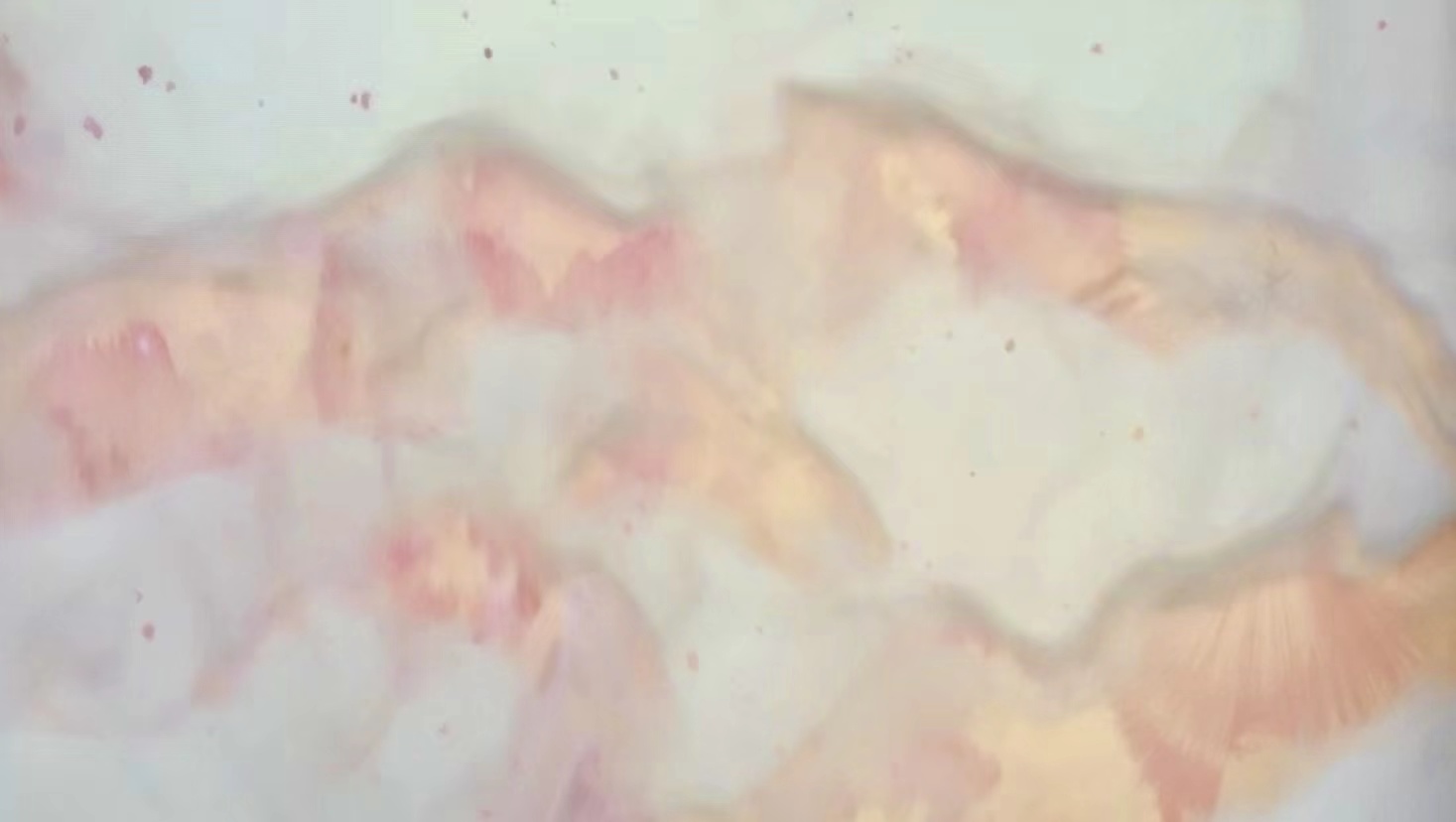
Screenshots of “Peach Fantasy”
The key to this ink-and-wash video work lies in how to explore new possibilities that cannot be realized by traditional ink and wash in cross-border experiments. While maintaining the elegant, warm and thick color presentation of Chinese paintings, the exploration and new media are constantly deduced and exchanged. I have seen a lot of video works related to ink painting. Many of them have good ideas, but there are often shortcomings in the realistic process. For example, what is the relationship between broken branches and stones? What kind of state should looking forward aim to be? How to skillfully use the space dimension, etc., this requires discerning and keen visual training.
The focus of my control is how to present and expand the texture and mystery of ink painting through digital technology. The video works are based on the layer-by-layer deduction of the graphics algorithm, and are introduced by the dense ink rhythm. The direction of the ink color and the image construction are related to the muscle memory of my painting and the inertia of the hand outline. How to control the level and purity of the ink color is also very important. I asked the team to make the ink color effect not “stuffy”, black but transparent.
When entering the expression of color next, according to the color of the “Peach Blossom Spring” series, some elements are extracted, and the growing tree and petals are generated by computer images, forming a process of a peach tree from a figurative image to abstract. The initial deduction plan was from figurative to abstract, and finally back to the image of the work: a figurative peach tree. I think it is better to let the digital peach tree grow, the more boundless, the better. Instead of setting limits for this video work, we seek an openness. Through complex programming, let the “falling colorful petals” float to a more unexpected expression, which is also the core of my consideration for this video work with Shanghai LIMAGE STUDIO. The rhythm of the entire moving image interacts with the audio data information driven by the algorithm, further exploring the resonance of vision and hearing.
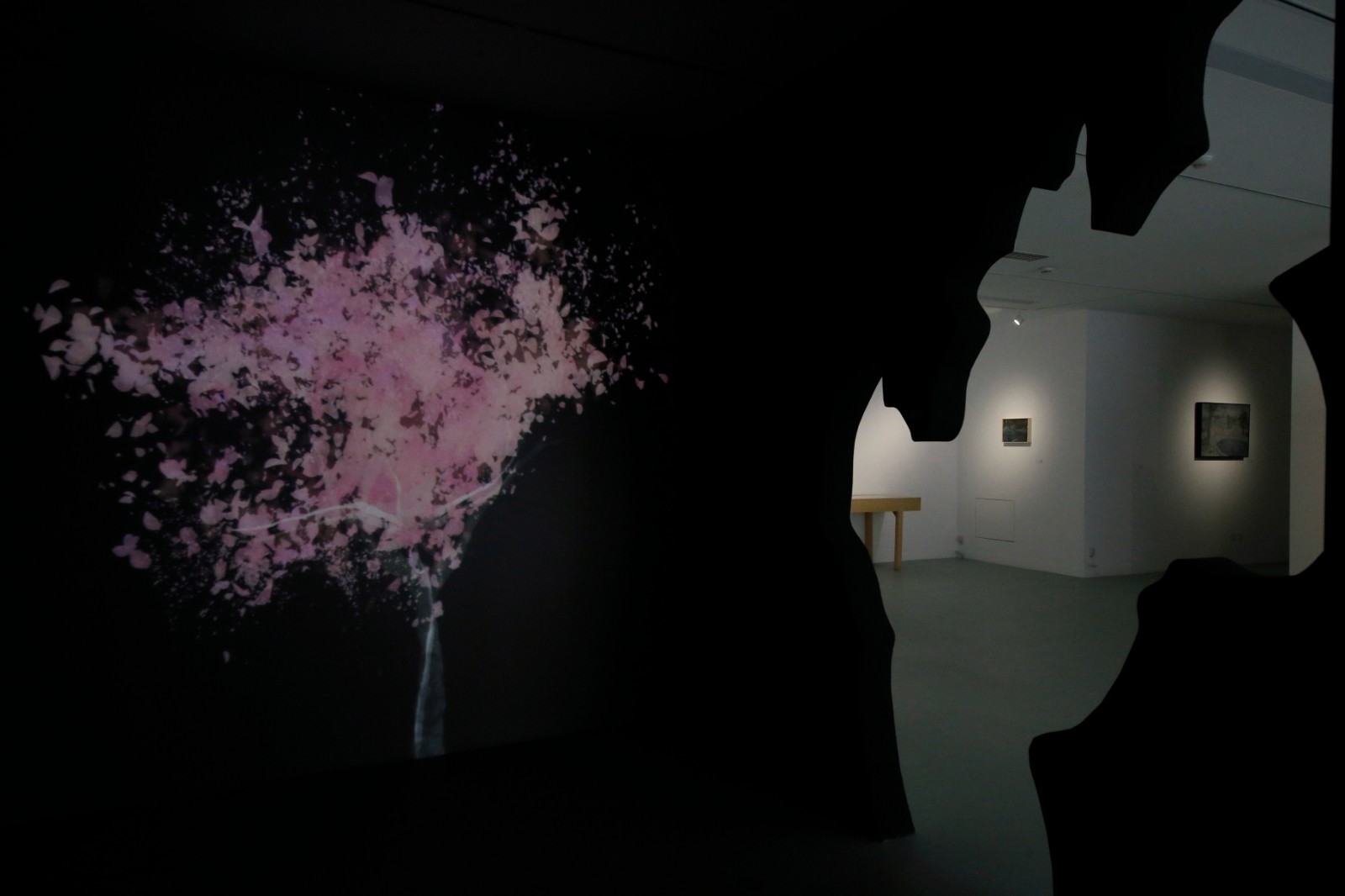
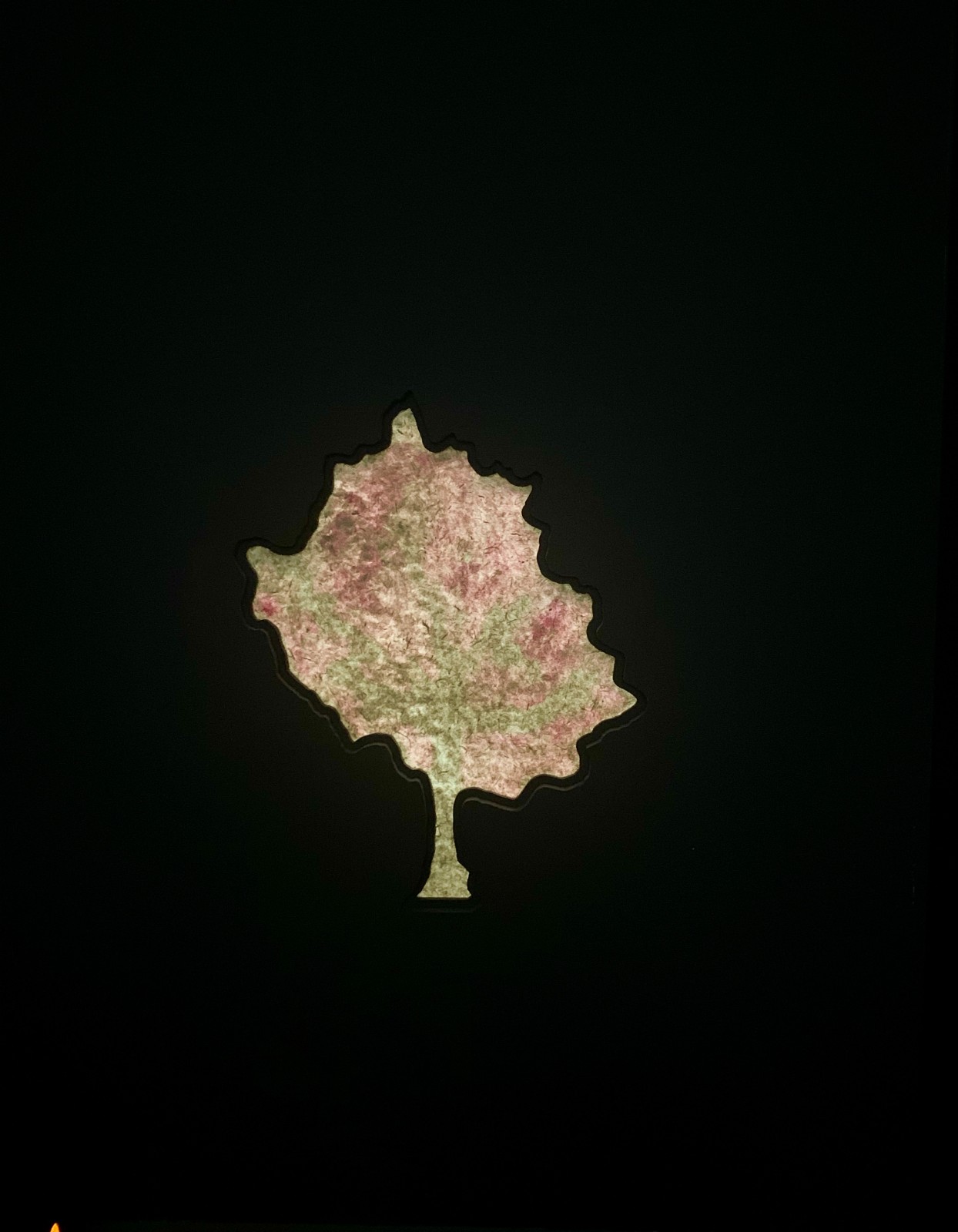
Exhibition View
At the opening scene, we also made a fragrance of peach blossom imagery for the guests. There was still a little fragrance in the video room. Together with music and video, the intention of “Peach Blossom Spring” can be sublimated to a certain level of sound, light, color, and fragrance. The music is also composed by specially invited composer Zhang Lu. When discussing the overall atmosphere with the composer, I hope that the music scale and the color scale will cooperate with each other. Beneath the blossoms, the long bagpipes and strings are illusory and mysterious, but the substrate has a heavy and distant tone. As the blooming flowers dissipated, the ink-and-wash clouds and mountains seemed to remain the same, but they were already dyed with the crimson color of “Peach Blossom Spring.” This work hopes to reconstruct a “Peach Blossom Spring” that belongs to the present with the most vivid and contemporary language techniques.
 Exhibition View
Exhibition View
There is also a piece of Taihu stone that I pinched in the exhibition. To construct this stone, I used the “reverse deduction method of narrative logic”: this stone does not exist in the world, but was made according to a stone I painted myself, and the painting method is also similar to that of the painters of the past dynasties. It was completely created by me, and it may be more appropriate to call it “Qiu Ting Stone.” In consideration of the exhibition space, I didn’t want it to be overwhelming, so I only exhibited one piece from the series, which will be enlarged to a size of two meters in the future. According to the Taihu Stone pattern created in my mind, from the image to the creation, it has formed a kind of “reverse operation” with the traditional way of generating Taihu Stone, and I think it is very interesting to make the stone in constant fine-tuning.
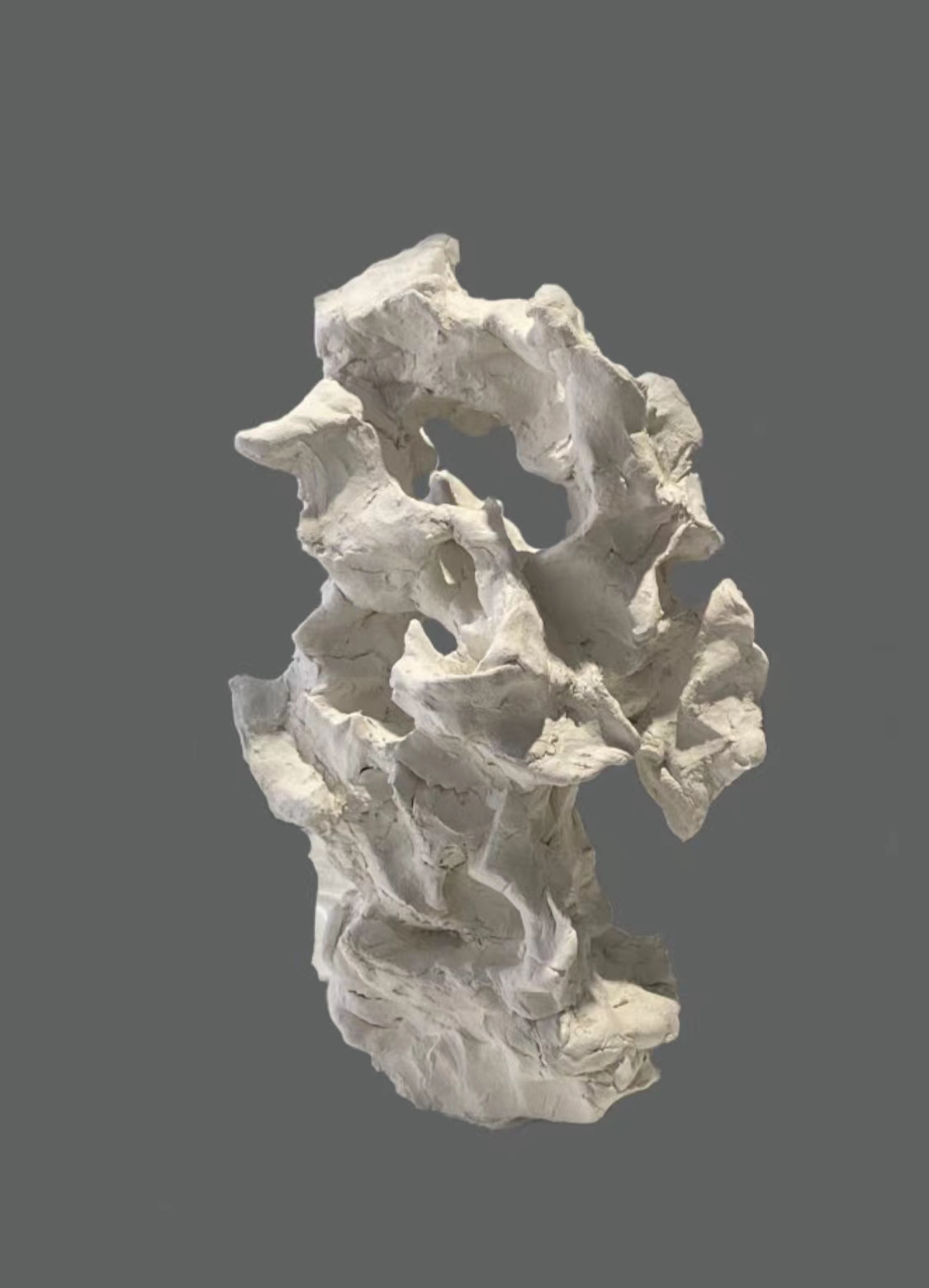
“Qiu Stone”, 28.5x16x9cm, sculpture clay, 2022
CAFA ART INFO: Your exhibition always seems to have a “postscript” like a verb, which seems to emphasize a process. What kind of “encounter” do you hope to achieve with the audience through such a “reconstruction of the Chinese collective utopia”?
Qiu Ting: The richness of a person’s inner world is always presented through a certain process. I try to explore the various possibilities of ink painting through experiments with new media, and present my “vision in landscape” with an open mind. What I really want to explore is the relationship between people and things, among people, and different states of people. I like keeping pets very much. I always feel that the state of a person’s treatment of small animals is actually like his outlook on the world.
Another example is in the Humble Administrator’s Garden, what impressed me the most was the “Pavilion of Sitting with Whom”. In order to commemorate the ancestors who made a fortune from making fans, Zhang Lvqian integrated pavilions, windows, doors, railings, door openings and plaques into the architecture. The seamless design from concept to landing in traditional culture was so moving! And the title has a new practical significance today. The current world is so chaotic, and there is a question raised by reflection and concern for nationalities, countries and individuals is whether we still have a certain tolerance and mind to sit with people from different cultures, beliefs, race, geopolitics, identities, prestige, status and educational backgrounds?

“Peach Blossom Spring 6”, ink and color on paper, 35.5×95.5cm, 2022
Then, the “encounter” introduced by “Peach Blossom Spring” is related to the spirit of freedom, poetry and transcendence in ancient Chinese culture. In the spring, I was trapped to the Area South of the Yangtze River due to the pandemic and was unable to return to Beijing. What is important is how we can adjust ourselves into an optimal state in the face of the present moment, and put peace and compassion in our creations. The color imagery in the “Peach Blossom Spring” series is both provocative and catching to the audience. First of all, I was impressed by it, then it can touch others.
References:
[1] [2] Foreword to the exhibition “Qiu Ting’s Peach Blossom Spring”, by Cong Tao
Image Courtesy of the Artist and the Organizer.




























